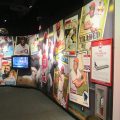South Jersey Life

Eagles Tailgating: The Greatest Party in Greater Philadelphia
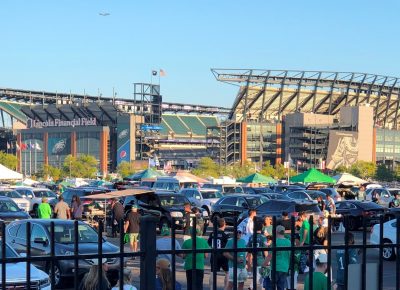
There is no gathering anywhere in the region like an Eagles tailgate. (Published for the Fall 2023 issue of PhillyMan…see the magazine article here.)

Most of the thousands clad in green at the party on Pattison probably don’t even realize it, but there is a truly special element to being in the parking lot on Eagles game day.
It’s that no matter your political persuasion, your religious denomination, your ancestral roots or your musical taste, you have something in common with the stranger next to you. In the parking lots surrounding Lincoln Financial Field on game day, everyone bleeds green and shows their commitment. On Game Day, the Birds are the only thing that matters to anyone.
Tailgating, at first glance, seems an alternative to paying the eternally brazen “atmosphere fee” for food and libations inside a sports venue. But when the party encompasses more than a square mile and looks like this, its purpose goes well beyond thrift. To call an Eagles tailgate a party, to even call it a celebration, is a rank understatement.
Throughout the lots at the home of the Eagles, including those meant for other teams who happen to play here, you can walk in any direction and see buses, campers, trucks and vans…the majority of them covered with artwork that would provoke a double take on the highway. It gives one pause to consider how much of a fan one must be to shell out the kind of coin needed to decorate a vehicle so magnificently.

After a long day of painting a bus, it’s time for a drink.
Everywhere in this mammoth block party, one hears loud music from a variety of styles and eras. Everywhere, you can smell coal, sausages, burgers, and yes, frequent whiffs of reefer. And anywhere you happen to be, you won’t often go five minutes without hearing an Eagles cheer…usually begun by one person, which easily gets at least a dozen more to join in.
If you’ve never been a part of tailgating at this level, you’ll be truly amazed at the dedication of a large number of participants. The seasoned pros arrive early…as much as six to eight hours before game time. (Do the math of how early you’d have to get out of bed, on a cold November Sunday morning, to tailgate for a 1:00 game.)
Veterans of Eagles tailgating even have their designated parking spots, that they head directly to when the gates open…for various reasons, such as being near a grate that can be used as a bathroom. True.
You can easily spot the amateurs…the late arrivals. They spend far too much time in an agonizingly slow quest…not only to find an open spot, but to work their way into it as carefully as possible to avoid gazebos, coolers, and equipment that other tailgaters have established hours before.
Hopefully they’ve learned their lesson from the experience…you need to take this party a heretofore unheard of other level of seriously.
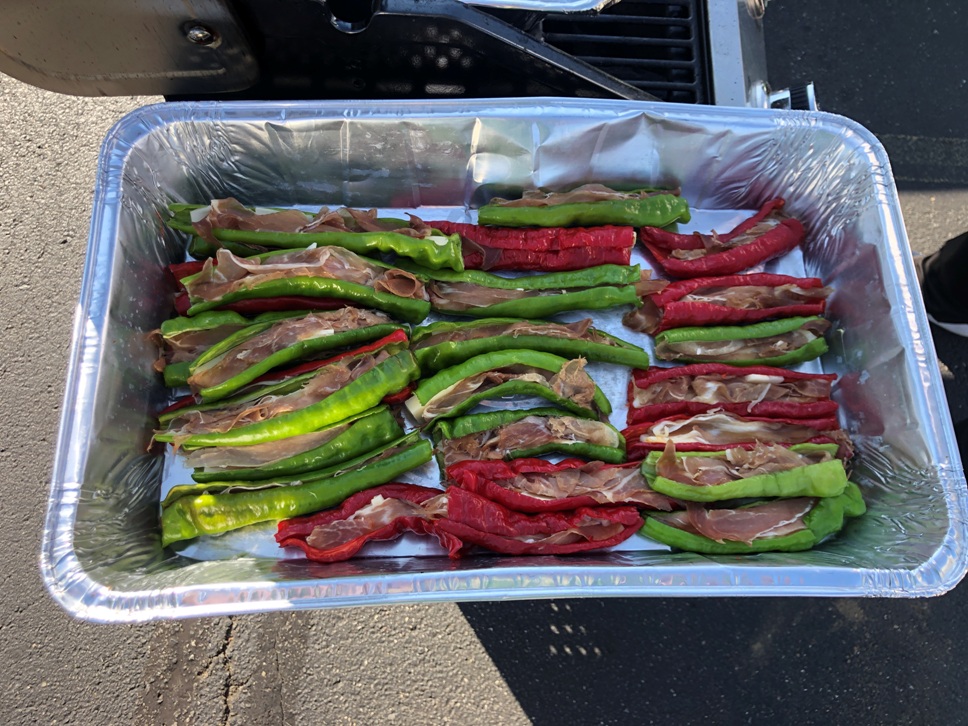
Dan Kukral’s stuffed long hots are reason enough to be part of the Danny Burke tailgate on game day.
Dan Kukral is the head chef of the Danny Burke tailgate, named for his brother-in-law who runs much of the party. He was given the chef’s role, he says, because “I come up with all the fun ideas for food.”
Kukral is a research scientist at a pharmaceutical company, which is remarkable given what you’re about to read about his contribution to game day.
He and Burke usually begin the party preparation about five to six days before game day (yes, you read that right). Once they’ve gathered food and supplies for a party that can be for as many as 200-300 people and brought it all to the Linc, he takes on the sizable cooking duties.
Needless to say, it’s a lot for one guy. Kukral simultaneously looks after the preparation of ribs, pulled pork, shrimp and sausage bayou, Buffalo chicken dip, and of course, dogs, burgers, wings, sausages with peppers and onions…even long hots with stuffed provolone and prosciutto. As anyone can easily see from the hefty, mouth-watering piles of grub, he’s more than up to the challenge.
It’s all a labor of love, he says. No kidding…a system as efficient as this doesn’t happen casually. The Danny Burke folks get contributions from participants, which covers the food and drink, but he doesn’t get paid for his more than considerable efforts.
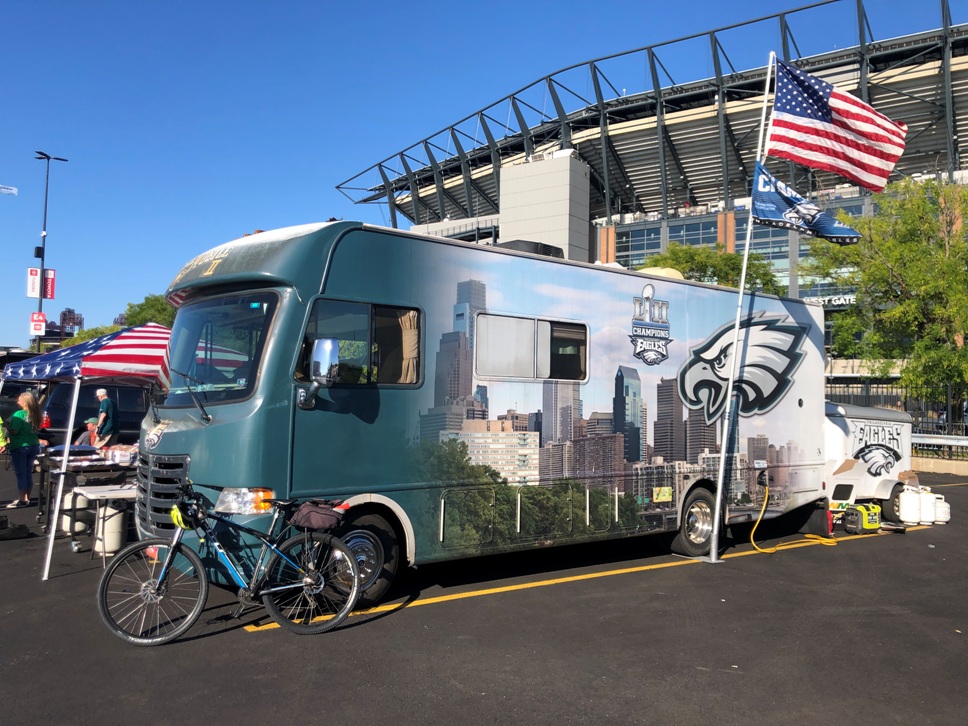
If you think this pain job is impressive, check out the back.
Kukral is just one of many for whom Eagles fandom is a passion worth the investment of time and money.
This observer also spoke with Ed Callahan, whose camper has occupied a spot in the Wells Fargo Center lot since the opening of Lincoln Financial Field. Ed tells an amusing story of why he and his crew acquired a camper.
“In 2004,” he recalls, “I went to a road trip game in Cleveland. There were four of us, and we parked in the lot next to a beat-up old RV. For a swap of a cheesesteak, the guy who owned the RV let us use the bathroom.”
An even trade, certainly. But bringing a bathroom to a tailgate, they realized, was a super idea, for obvious reasons.
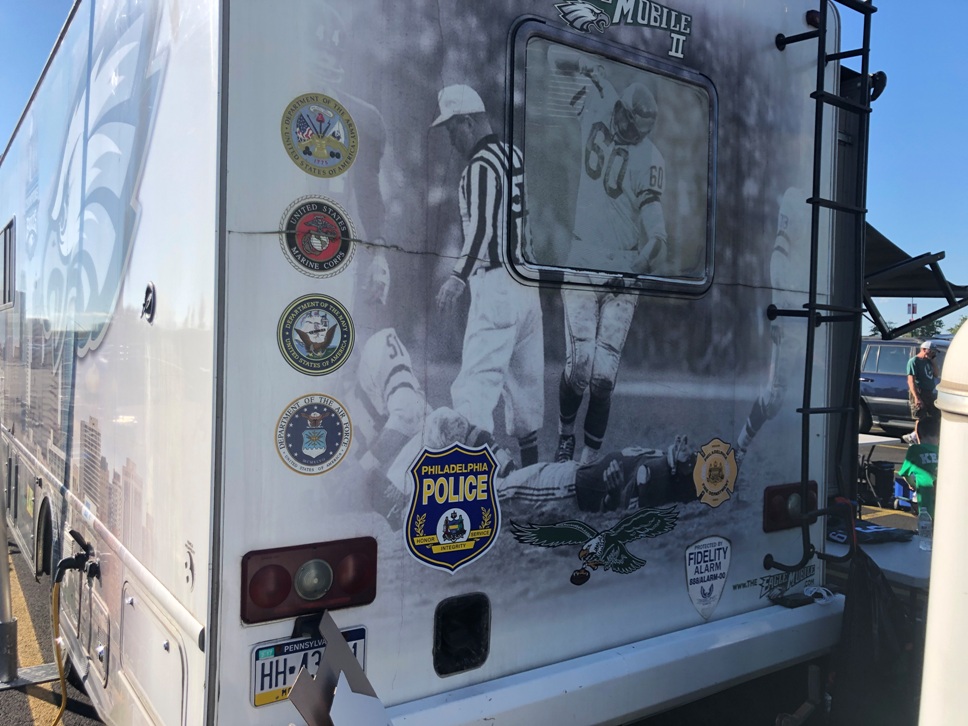
“I’ll knock the loyalty to Kathie Lee right out of you!!”
Ed and his crew bought an old RV, fixed it up, and made it a staple of the parking lot. They eventually had to replace it following a wreck, so they’ve upgraded to a new one.
Callahan’s current camper is a thing of beauty to behold for a Philadelphia football fan, and it might be the most artfully decorated vehicle at the Eagles tailgate…which is undeniably saying something. The back of the RV is adorned with a large scale timeless image of Frank Gifford lying motionless on the field, following the epic Chuck Bednarik hit. On the side is a wide panorama skyline shot of our city, ranging from 30th Street Station to Billy Penn’s statue.

Anthony is the right man for the job.
The cook of Callahan’s crew is a gentleman named Anthony. Anthony is definitely keeping busy looking after sausages and other comestibles. He estimates that their party serves anywhere from 30-100 fans each home game.
Executing a successful tailgate, Anthony says, is a full-time job. “All week, getting food together, cleaning the RV, getting all the grills, utensils, tables, and all that. It’s a full day…breakfast, lunch and dinner in the parking lot.”
Ed says their breakfast specialty is an Irish American Philly Omelet… made with imported Kerrygold cheese from Ireland, Cooper brand American cheese, and Philadelphia cream cheese, all in a three egg concoction.
There might be a few NFL cities that are in Philadelphia’s universe when it comes to the magnitude of the pre-game party. But there is one thing that The City of Brotherly Love offers that is unique: cheesesteaks, scrapple and pork roll.
Buffalo can keep their wings, December weather, and four straight Bowl defeats.

These people need a lot of stuff.
To witness football fan dedication of this level brings to mind a whole world of entrepreneurial opportunities for local businesses. Incidentally, our friends at Duck Donuts realized this…on the day this article was written, the author received an email with a subject line that read: “Win The Tailgate With Donuts!” They get it.
Sure, for liquor stores, sandwich shops and food markets in the area, it’s obvious. Put it in your promotional materials that you offer everything Eagles fans need for Game Day…cases of beer, large bottles of liquor and mixers. Ready-made subs and pizzas, bulk packages of burgers, sausages, chips, dips, and rolls.
But that’s just scratching the surface. A party this size needs it all.

“Say, who painted your RV?”
An owner of an RV dealership can add a bar and lounge to the inside of a used camper to make a sale to a dedicated Eagles supporter. Vehicle wrapping and decorating outfits could market their wares to fanatics that buy multiple spots at considerable cost for their RV.
Needless to say, anyone selling Eagles gear could market to the block party…most all of whom represent their team faithfully with jerseys, caps, face paint or any kind of accessories featuring the Eagles logo and colors.
Outdoor stores could make a serious profit too. Grills, propane tanks, coolers, generators, portable toilets, anything associated with RV adventures might be applicable to a tailgating demographic. Space heaters and fuel would undoubtedly be in big demand in the colder months. Decorating anything with the Eagles colors and logo could make the sale to the typical Linc lot enthusiast.
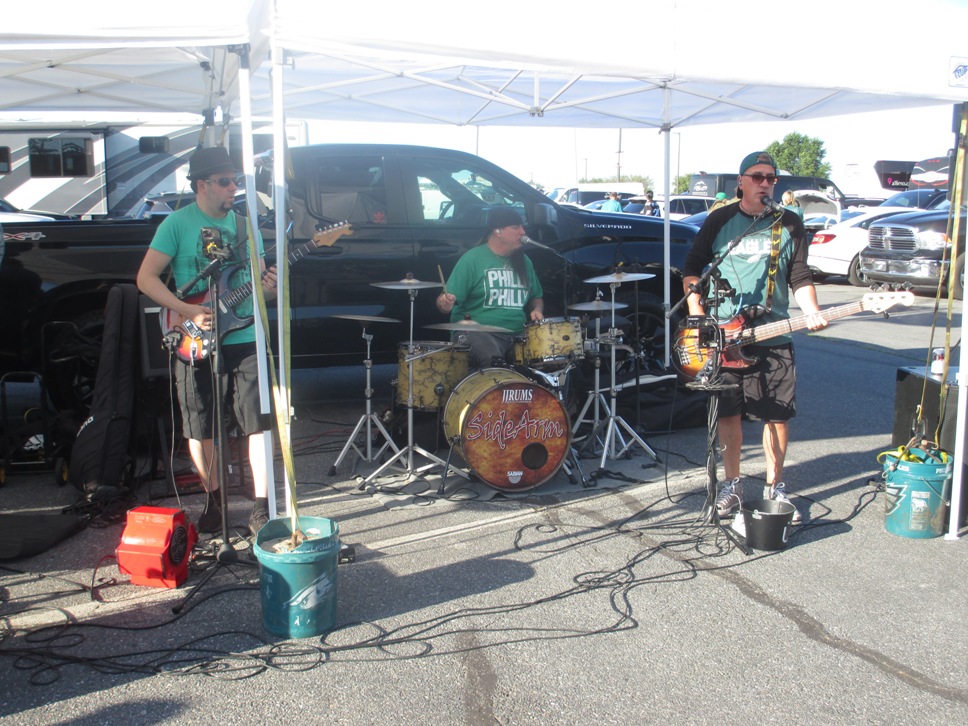
This band was playing Van Halen’s “Unchained”, and the guitar player handled himself quite well. It’s no place for amateurs.
It’s even an opportunity for catering services, private event coordinators, DJs, even live musicians, all of which you can easily find at an Eagles tailgate.
If nothing else, fly a plane towing a banner over it all for the thousands in the lot to see…which also happens frequently.
You get the idea, but even if you’re a realtor or a financial advisor, there’s no reason why you can’t build goodwill by renting a camper, hosting a game day party and inviting your customers, as one business owner (who asked for her name not to be shared) does.
No doubt, your Eagles fan patrons will speak well of you.
Because after all, you’re family.
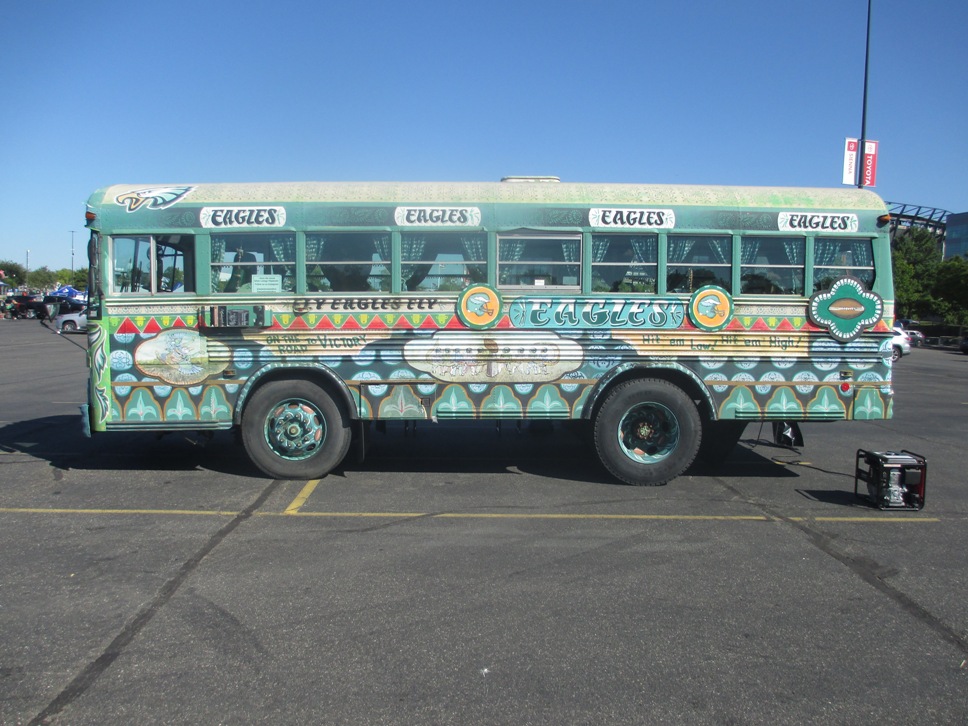
As seen on the movie screen!
As Seen In The Movies: The Silver Linings Playbook Eagles Bus
If you’ve ever seen the movie Silver Linings Playbook…and if you’re a Philadelphian, you should…you likely remember the scene where the Eagles-decorated “Asian Invasion” bus shows up in the Linc’s parking lot on game day.
In the scene, protagonist Pat Solitano Jr., has just been released from a mental health facility for bipolar disorder. At the game, he notices that his therapist, Dr. Cliff Patel, has emerged from the bus.
He catches up with Patel…whose face is painted green and silver…and Patel dispels any concerns about their meeting outside of the facility: “Today, I’m your brother in green, not your therapist.” Soon, the two have a discussion with Pat’s friend about what the Eagles strategy for the game should be, punctuated with hilarious foul language.
After the movie was made, no one really knew what to do with the bus, and so a movie hand decided to sell it on Craigslist.
Bill Curley, a long, long time veteran of Eagles tailgates, went for it, and today the Asian Invasion bus is parked in the Wells Fargo lot for every Eagles home game.
“One of the people working on the movie ended up with the bus, and nobody wanted it,” Curley remembers. “The Inquirer wrote an article about how the bus was for sale prior to the Super Bowl. Once they won it, I called the guy on the phone and said, ‘hey is the bus for sale?’ and he said yes.”

The author of A Great Number of Things enjoys some time in the Asian Invasion bus.
Curley bought the bus for $9,000 in 2017. He estimates that he’s put a total of $30,000 into the investment. The bus is comfortably remodeled inside, with cushioned benches and Eagles decorated chairs, offering a spot to escape weather that can be trying in this part of the world any time of year.
“I come here early and park right here at the end, so people can take pictures. It attracts people from all over the country, I’ve had several people from Canada. A lot of ‘this is my first game, I’m from Utah, it was a birthday gift,’ they come and introduce themselves. It’s a neat thing.”
He still gets into the party, showing up early, saving spots for family and friends, and cooking sausage and peppers for whoever shows up. He was at the Linc at 11:30 AM for the Thursday evening home opener. “It starts early and it ends late,” he laughs. “My daughter’s coming today with her friends.
“This isn’t the most comfortable thing to drive in traffic, so I leave early.”
If you’d like to see the movie scene, you can search for “Silver Lining Playbook Eagles Tailgate Scene” on YouTube. And the next time you’re at an Eagles home game, check out the Asian Invasion bus…it’s well worth a look.
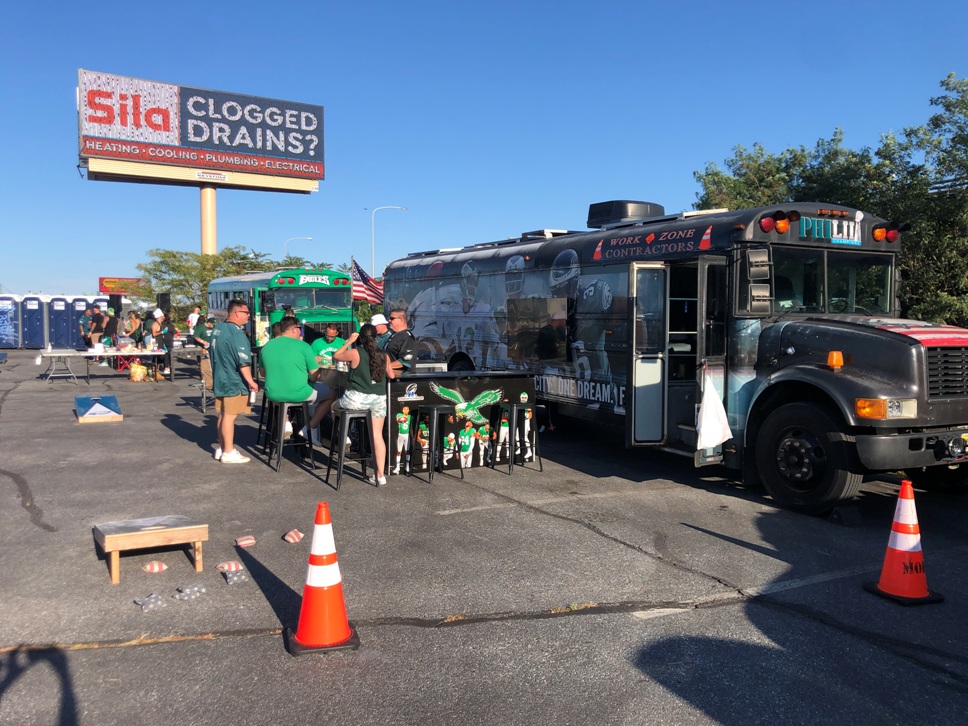
They mean it in the Jetro lot.
The Jetro Lot
While the Eagles tailgating scene is a thing to behold throughout all of the parking lots, some lots are at a different level of enthusiasm than others, and the parking lots at the Jetro Warehouse east of the Linc are undoubtedly the wildest.
To Philadelphians, the name “Jetro” is probably more known for what takes place in their parking lots than for what they do…they are a wholesale restaurant supplier, selling catering supplies and food preparation equipment to caterers and restaurant owners throughout the region.
But it’s likely that their most important…and maybe profitable…contribution to the city is their ample amount of parking spaces in the Sports Complex. The Jetro folks are, needless to say, aware of this, and they even have Facebook and Twitter pages dedicated expressly to their parking offerings for Philly sports events.
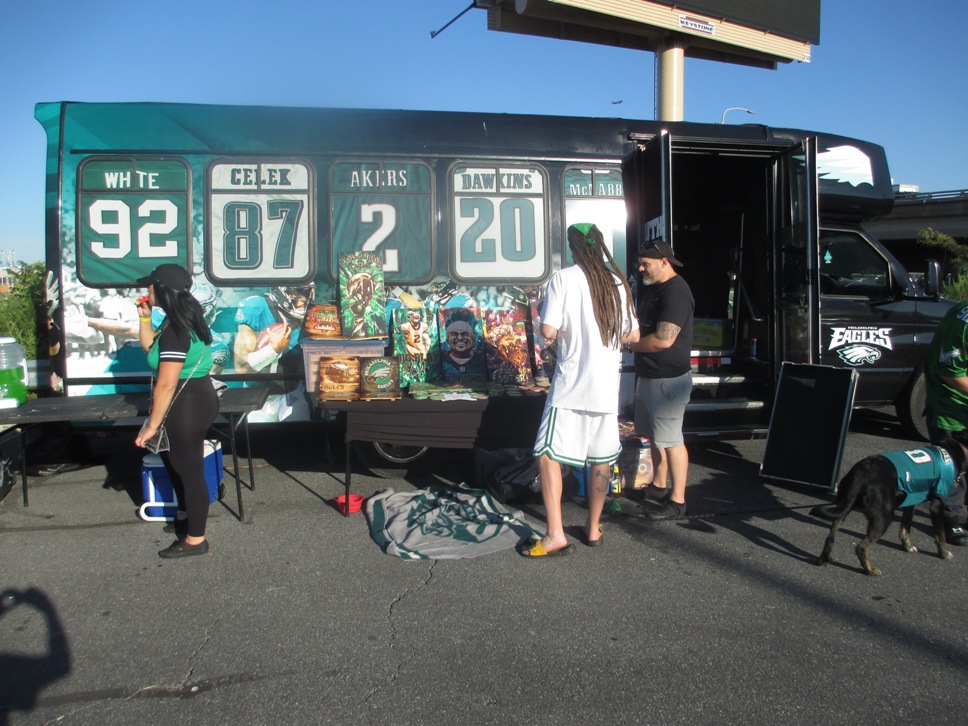
The art stylings of Jonathan Metz.
The most serious of Philly tailgaters seem to congregate at Jetro. In this observer’s visit, just a small sampling of things to see were a large number of beautifully decorated buses, a gentleman by the name of Jonathan Metz selling superbly Eagles-themed woodworks, coasters and other items, and a live band whose guitar player could mimic Eddie Van Halen’s licks quite well. That’s a ridiculously small sample, but magazines have space limits.
Jetro’s lot isn’t a place where you’d want to bring the kids or your church group. It’s loud and raucous, with music that often features lyrics full of f-bombs. There’s also a few flags that are openly critical of the current occupant of the White House, and not in a polite way.
But if you can handle that, and you truly want to show your Eagles fan dedication, the Jetro lot is likely the destination for you. It’s well worth a visit, if only just to see the level of fandom the local football team inspires.

It’s A Dog’s Life – Animal Aid USA

The volunteers at Animal Aid USA take a trip to rural Georgia every four weeks, to rescue stray and abandoned dogs and give them a home. To date they have rescued 40,000 dogs from unimaginable conditions. This story appeared in the spring 2023 issue of JerseyMan, you can read the magazine version here.

You want to give them names already, don’t you? (photo courtesy of Karen Talbot)
It’s A Dog’s Life
Our canine friends teach us one of the most important lessons of life: it’s too short for anything less than unconditional love, compassion and forgiveness, all the time.
Karen Talbot, Rachel Monaghan and the volunteers at Animal Aid USA have taken that lesson to heart. Their mission is to return the favor of unconditional love, to as many dogs as possible.
As anyone who participates in their rescue caravans can tell you, it’s a big challenge. Talbot herself says it’s not for everyone. “It’s grueling on that road.”
Animal Aid USA gathers volunteers, vehicles, water bowls, blankets, crates, and whatever else is needed, for a trip to rural Georgia from Williamstown every 28 days. They then gather abandoned dogs from local shelters in the area, load the dogs into vehicles, and take a 16-hour overnight drive back to New Jersey, to place dogs with no-kill shelters to be adopted.
A 64-word paragraph can’t begin to capture the level of effort involved in the operation. Monaghan, a regular volunteer, describes the process:
“We leave at 6:00 at night and arrive in Georgia around 9:00 AM the next day,” she explains. “Once we get down there, we prepare our vans with water bowls and line all our crates. If we have litters of puppies in our vans, we’ll extra line the crates, because we have to usually change them while we’re driving.
“That’s usually on a Thursday. Friday is when we do all of our preparation. In the morning, we’ll clean kennels again, and then we prepare for transport. We usually have about 30 crates in each van, we put in puppy pads and towels or blankets in all the crates. Karen tags them all, so we know which dogs are gonna be in our van. We prepare extra water bowls, extra towels and stuff to clean up any messes that happen.”
“At around 4:00, we start the load, we’re out of there by 5:15. Everyone’s just going in every direction. It’s like all hands on deck.”
Talbot, who spends much of her life preparing for the trips, likens it to a Broadway production.
“All of the preparation and the dress rehearsals and everything that you have to do lead up to one moment, and that one moment is “It’s load-up time”. That’s when everything has to be done done done, because the first dog in is gonna be in there the longest, and it’s all about getting them all in the right crates, and making sure everybody fits.
“Once they’re all in, we do our giant prayer circle and we’re off.”
The crew of vehicles with its precious cargo, including the rig mostly driven by Talbot’s husband Dante, then drives through the night…the only time D.C. traffic on I-95 is avoidable…back to New Jersey, where dogs are unloaded and placed with Animal Aid USA’s adoption partners. The project is both exhilarating and exhausting.
“Then you get home and you crash,” Monaghan laughs.
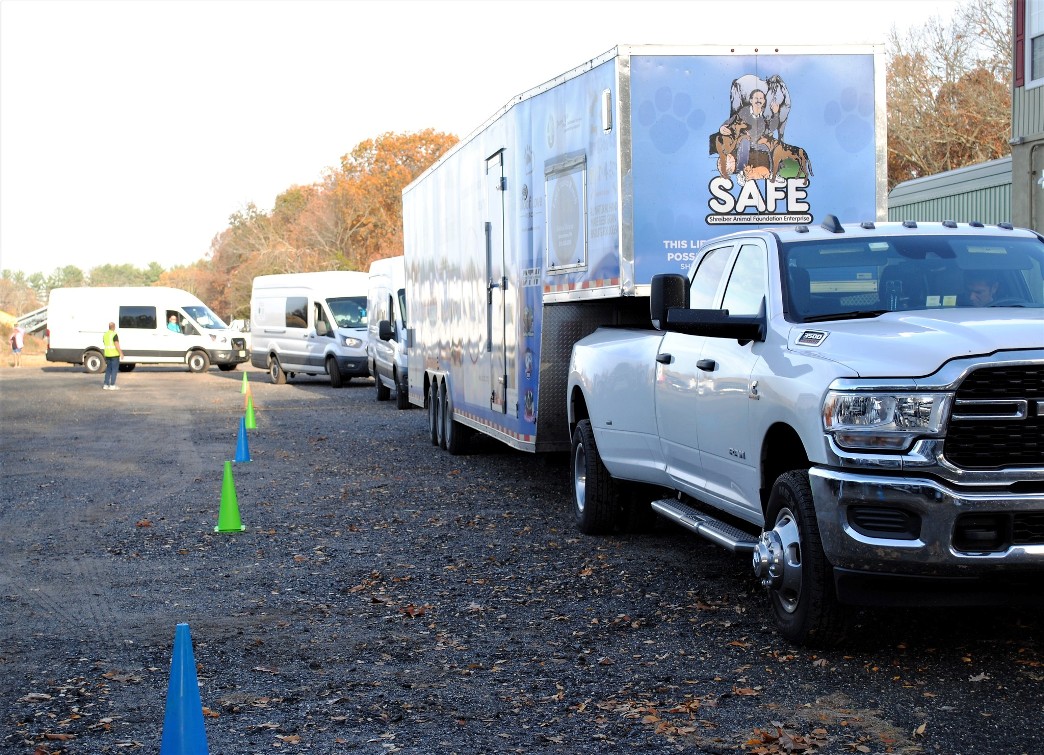
A truck full of dogs headed to be adopted in NJ. (photo courtesy of Karen Talbot)
So why rural Georgia, 16 hours away, every four weeks? Surely there are plenty of stray and abandoned animals in New Jersey?
Probably. But in Georgia and several other states, many rural counties don’t have the resources to care for stray dogs. Sadly, it isn’t often even for a lack of funding. There’s simply a different attitude towards dogs in the places where the caravan goes.
It was quite the culture shock for Talbot, as it would be for any animal lover.
“Animals are not viewed the way they are up here,” she says. “They’re not household pets, they’re not family members. They are yard dogs, they’re a nuisance.
“They don’t have the same empathy and compassion. The majority of people could care less about animals, and the minority of animal lovers are really fighting a bad war.”
She remembers witnessing how the situation reaches a tragically mind-numbing level for many people.
“When I first started going, I was so angry with them at first. Like, ‘Wait a second, you mean to tell me that you love animals, but you drove past a litter of puppies on the side of the road? What the hell kind of an animal lover are you?’
“But as I got to know these people, I realized they have 40 dogs at their house because they stopped 40 times, and now they can’t feed their families, now they don’t have food. They’re being threatened with eviction, they’re being threatened with divorce. They have to put blinders on, because sadly that’s where they live.”
Like all of the volunteers, after being a part of so many caravans, Monaghan has seen heart-wrenching stories of dog abandonment too.
“There was a case where, I guess the person went to jail, there were these Chihuahuas. The house had to be condemned. It was so disgusting, they were living in layers of poop and pee, it was just horrible. And again, the police, they didn’t want to deal with it.”
Monaghan laments that “All the shelters are pretty much kill shelters. None of them do public adoptions or rescue. If they’re not claimed by their owner, they usually get euthanized.”
Talbot describes the horrific conditions that dogs endure. “They’re not even shelters. They’re death holes. They’re a cinder block hut with a car port over top that they call a shelter. There’s no A/C, there’s no heat, some of them don’t get fed. They’re just there to hold until they’re killed.”
Hearing the stories can take an observer from “Why do people do all of this to rescue dogs?” to “How can anyone with a heart not do something?”

Rachel Monaghan (right) with a new bestest buddy. (photo courtesy of Rachel Monaghan)
In Rachel Monaghan’s case, she wanted to do something to overcome her grief after losing her own dog unexpectedly. She learned about Animal Aid USA through a friend, and has been hooked ever since her first trip.
“I was planning on going to three trips that year,” she remembers, “and I ended up going on I think six. I just became a regular caravan member.
“The best part for me is seeing the transformation. Obviously it’s awful what they go through, but seeing the resilience of them, and how they just still continue to love and trust people.”
Talbot says of the people giving their time to the caravan, “I’ve discovered that it’s not just them saving dogs. This movement has saved them. It’s saved their marriages, it’s stopped them from drinking, it’s made their life better at home. It’s their outlet to get away for a while to do something bigger than them.
“Nobody gets that until you come on a trip. Our motto at camp is ‘Our strangers leave as family’. And it happens to everybody. If you have a soul, it happens to you. It can’t not.”
In the face of a mentality that has existed for generations in this part of the world, Talbot and her team have taken on the most difficult of tasks: not just rescuing dogs…over 40,000 of them now…but also changing an established mindset that creates the need for their rescuing.
“You see it, in just the blank stares,” Talbot says. “People cannot believe that first of all, we would drive that far for a dog, and second of all, why?
“What we’ve learned is with our continuous journeys there, and the trust that we’ve built with these people. They know we’re not there to do anything except help. We want to change the next generation, we want to break this cycle, which we are.”
Talbot has seen that transformation in personal relationships, such as with a hardened animal control officer who now reaches out to Karen for help with dogs he finds.
“We laugh about it today,” she reflects. “When he first met me, he grunted at me, wouldn’t even make eye contact with me. I said look, I’m not here to point fingers, I’m here to help.
“A couple of years went by and he started to talk to me, he gave me his cell phone number. Then a couple of years later he was just like, ‘Hey, Karen, listen, I got so and so dog that just came in, you think y’all can take this one?’
“And this relationship blossomed. Plus some Tastykake cupcakes from up here helped too,” she adds with a chuckle.
Karen Talbot doesn’t spotlight her own role in rescuing dogs, even though it’s considerable. To her, it’s simply her life’s work. She always emphasizes the word “we” when speaking of the efforts of everyone involved.
“I had an idea, and I had a vision, but a vision is just a vision unless an army comes together to actually make that vision become a reality. We’re all volunteer, it’s just a life-long mission of ours.”
By providing the education, awareness and resources, she says, “We are empowering the next generation to make change in their world for companion animals. You’ve got rescue groups all over. But are you changing the mindset while you’re doing it?
“We are, and I think that’s what I’m most proud of.”
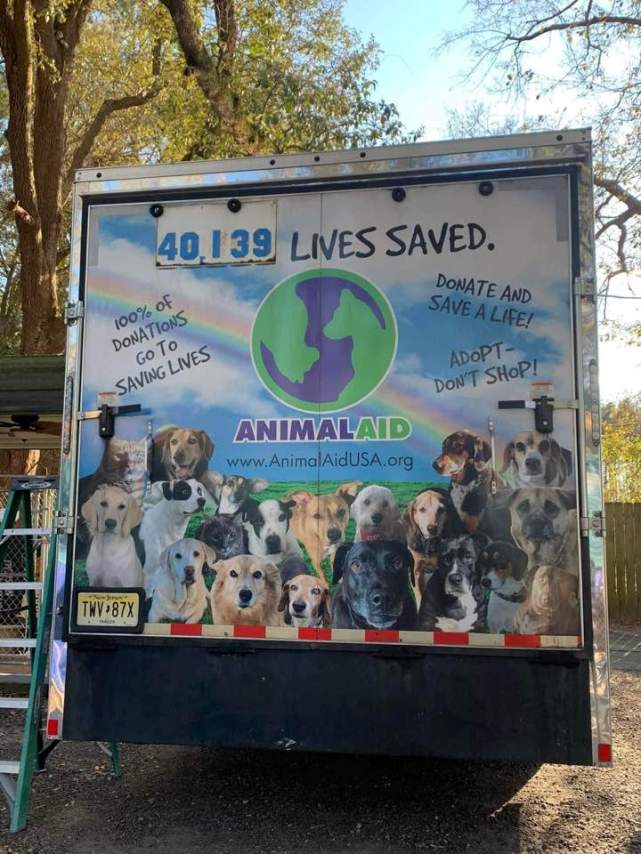
And counting. (photo courtesy of Karen Talbot)
An Animal Loving Bachelor
The rescue caravans at Animal Aid USA operated under different names in its early years, including MOMS (Making Of Miracle Stories) Rescue and Paws For A Cause, as Karen Talbot worked to raise awareness of dog rescues in rural Georgia.
Talbot fondly recalls the story of the huge contribution from Lorenzo Borghese, a name you may know…he was The Bachelor in the show’s ninth season. Borghese is an animal lover himself, and he wanted to help when he saw a documentary about the rescue operation.
As Talbot understood, his endorsement meant far more than a financial contribution he could have made.
“I was contacted by somebody who knew Lorenzo,” she remembers. “They wanted me to get introduced because (Talbot’s husband) Dante and I had started to take trips to Georgia. We went on our first trip in January of 2011, and on that trip, we had a borrowed van and we went down for 23 puppies.
“Once I met with Lorenzo, what I loved about him was there weren’t layers to get to him. He was the real deal, he reached out to me personally. I gave him a copy of the documentary which we had done.
“He knew that Dante and I were going back and forth to Georgia and funding everything on our own dollars and credit cards. Once he left our meeting he went home, watched this 25-minute documentary and was hooked.
“He said, ‘Are you looking for a check? Are you looking for money?’ I said, ‘No, I don’t want your money. I want something more important. I want a voice. People know who you are, they recognize you, they don’t know me.’”
Borghese suggested creating Animal Aid as an umbrella for MOMS Rescue, which he then lent his endorsement to. The “USA” was added when they learned that another “Animal Aid” already existed.
“That’s when Animal Aid was born, and so we incorporated Animal Aid is a non-profit. All the while, I still kept Making Of Miracle Stories, and Animal Aid just took off.”
Borghese adding his voice undoubtedly helped the effort. Talbot made a wise choice asking for it over a check…which she says would have been spent in a week and immediately forgotten.

Being adorable in their natural state. (photo courtesy of Karen Talbot)
The Video
On the Animal Aid USA website, you can watch a video of their being featured on “To The Rescue” docuseries, with host Tommy Habeeb narrating the full experience of the caravan going back and forth from Williamstown.
The video shows the Georgia compound where dogs are held until the caravan arrives, as well as the medical facility where vets handle spays, neuters, and heartworm treatments. Habeeb hears about the entire process from Talbot, who describes the logistics from dog food deliveries to the 38-foot transport rig that holds 64 crates.
Throughout the video, you see Georgia dogs in their natural state of being adorable, making the work that Talbot describes as grueling seem not only worth the effort, but not difficult at all. But Talbot shares that people are exhausted by the end of the project, wondering what they’ve signed on for, until the sun comes up during the ride home and they see the light at the end of the tunnel.
The caravans could easily be a reality show, you might think while watching. But Talbot is quick to shoot down pitching the idea of a reality show to a network, as this writer suggested.
“It’s a real reality show every 28 days down there,” she says. “But for me, living it on a daily basis and being in Georgia…Rachel’s amazing, it’s not a bad idea for her to set up a YouTube channel with a following, where we are real and raw.
“You’re not getting raw in reality TV. And you’re also controlled, and it’s scripted, and I am the furthest from being controlled or scripted.
“They don’t like that at all!” she says with a laugh.
The video is well worth a watch…go here to see it.
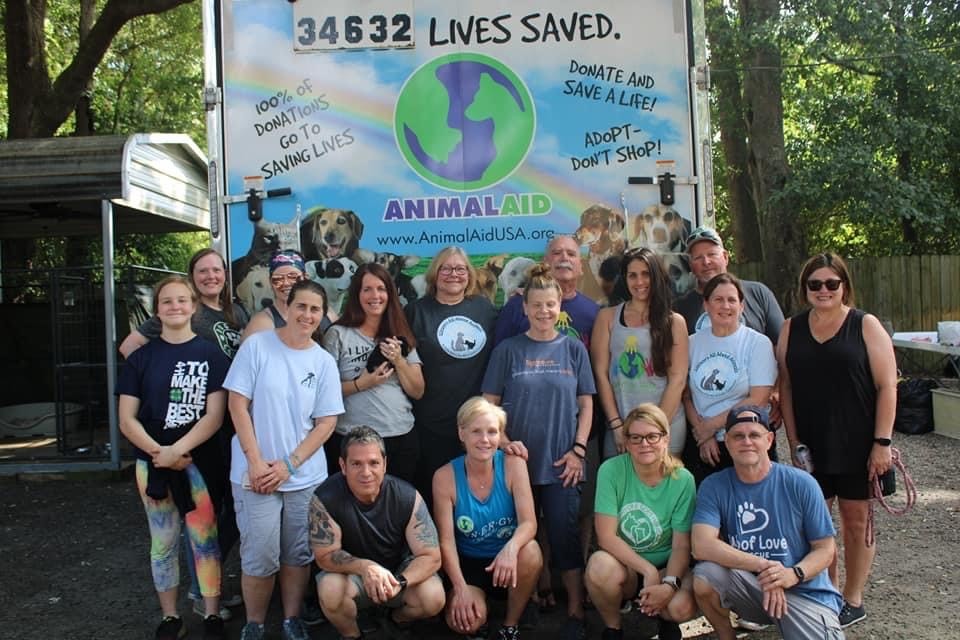
You are welcome to come join them. It’s life transforming. (photo courtesy of Rachel Monaghan)
Put It On Your Bucket List
Karen Talbot and Rachel Monaghan were happy to invite this observer to join them for a caravan trip. It’s something to consider, even if you just like long overnight road trips and need a worthwhile reason.
As Talbot says, the caravan has even saved marriages, and she cites her own as an example. Her husband Dante, who now drives and maintains the big rig of the caravan, had at one point tired of her devotion to the cause and requested a divorce.
“I immediately chose the dogs,” Talbot says.
“The following summer after the giant Georgia puppy caravan, we then had our documentary premiere in Philadelphia, and all the people that came on the caravan…the pilot, the rescue groups, everybody, was in attendance at the Trocadero.
“Dante was there because we were still friends, and he saw what I was doing from our bedroom on a computer, and he vowed to make it up to me the rest of my life if we got back together.”
The power of puppy faces. “It’s really funny because the reason we divorced was dogs, and once we re-married and got back together again, he’s worse than I am with dogs.”
Hopefully your marriage isn’t in need of helping dogs to save it, but if you’re interested in lending a hand and the life transformation that all of the volunteers speak about, you can reach out on the Animal Aid USA website and see if they need help with the caravans, which they usually do.
“Put it on a bucket list at least once in your life,” says Talbot.

Foodie Hall in Cherry Hill

The best assignments a writer could ask for are the ones that include free food…but especially when that food is from recipes concocted by gourmet chefs. JerseyMan sent me to cover the opening of FoodieHall in Cherry Hill…a great place for outstanding grub. Check out the article from the magazine here.
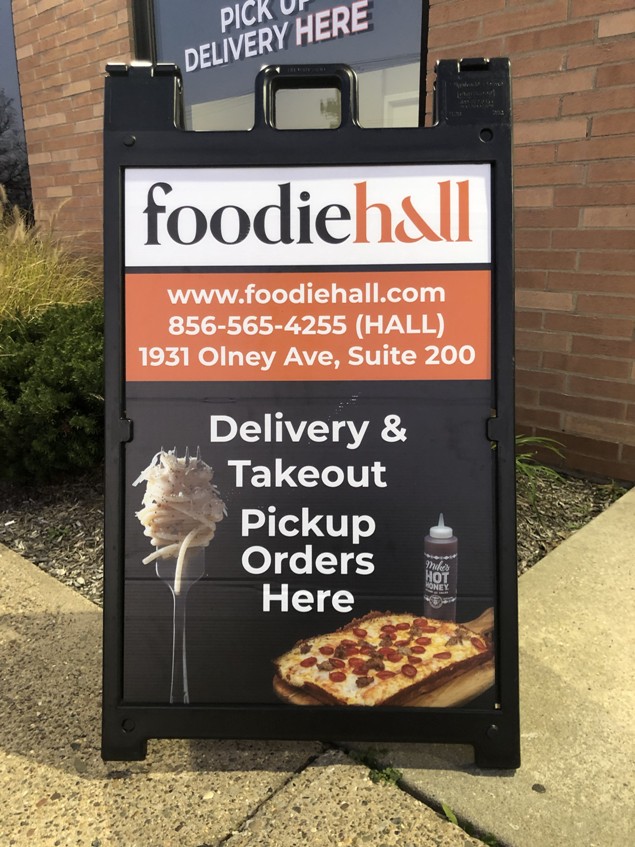
Hall of Food
The new Foodie Hall in Cherry Hill is a revolutionary concept – first rate food prepared specifically for takeout and delivery, while offering something for every taste.
For you JerseyMan readers and Legacy Club faithful, since membership has its perks, we’re about to share privileged information with you. If you’re on a plane or train, check that no one is looking over your shoulder, and that there are no surveillance cameras nearby. We’re entrusting you as someone with a need to know.
Here it is: You can now get a Geno’s cheesesteak in South Jersey.
Okay, maybe it doesn’t sound that momentous. Tony Luke’s, Primo, DiNic’s and other iconic Philly sandwich shops have all opened outposts across the Delaware, sparing their enthusiasts in our neck of the woods considerable congestion.
But for Geno’s, expansion from its 56-year South Philly location has been minimal. You can find a couple of locations in the city, like the airport. But until very recently, a Jersey dweller had to pay bridge toll to sample a Geno’s cheesesteak.
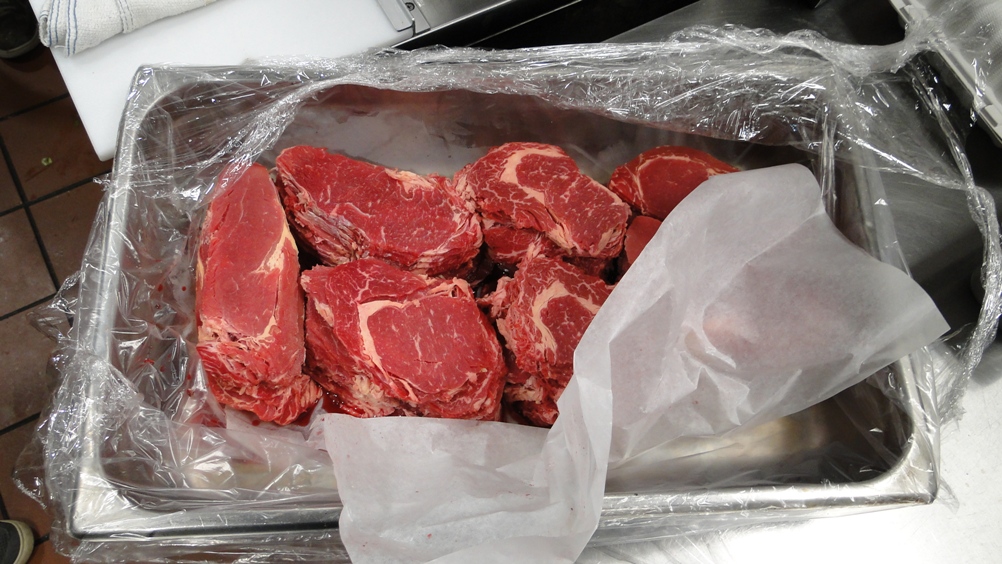
It’s the meat. Geno’s won’t have it any other way.
Dan Goldberg, co-owner of the Foodie Hall in Cherry Hill that now offers the essential Philly sandwich, helped to make this unprecedented happening possible.
“We’re very excited about it,” Goldberg says. “Our PR firm had a relationship with Geno, and made the introduction. We pitched Geno on the idea, and surprisingly to us, he was receptive.
“Geno’s has never expanded outside of Philadelphia, ever. So for us, this was a really exciting opportunity. Geno toured our facility, was very impressed with the layout, the cleanliness, and the whole thought that we put behind it, and said he was interested.”
And so you know, Goldberg didn’t just throw a few bucks at Geno Vento to use his signage. Thankfully, Geno is more protective of his brand than that.
“We worked out our deal, and went through extensive training with Geno to make sure that the Geno’s steak you have here in Cherry Hill is the same Geno’s steak you’ll have in South Philly. Which is not only important to us, but obviously important to Geno as well. It’s literally his name on the marquee.
“Geno was adamant, because he’s approached all the time, he wants to make sure there’s consistency across his locations.”
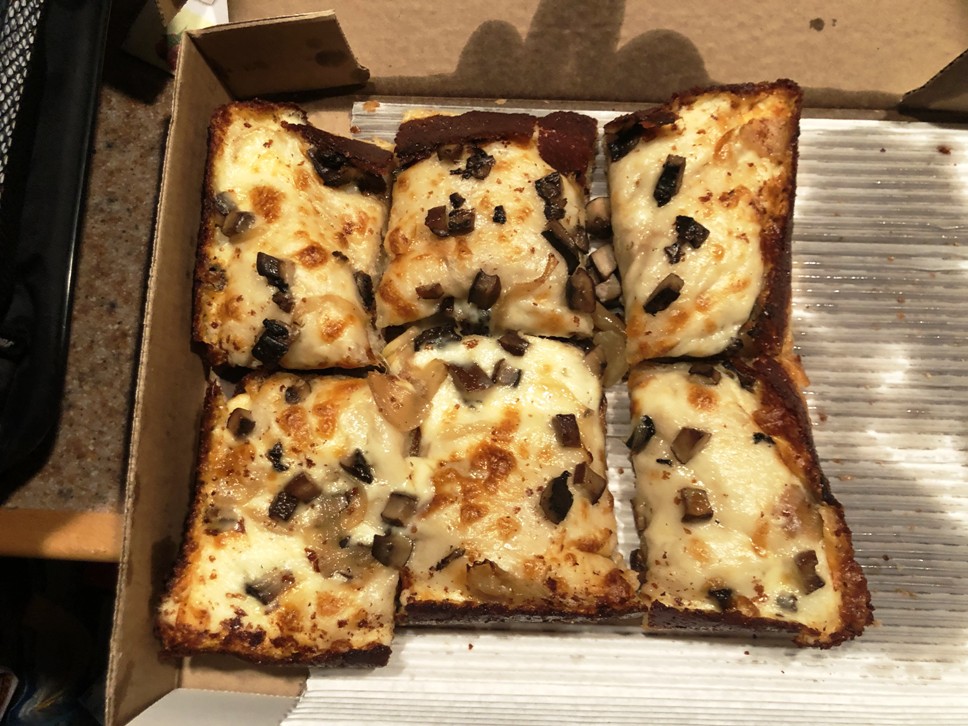
Not just Detroit-style pizza…Detroit-style pizza created by a gourmet chef.
To successfully persuade Geno’s to be a part of Foodie Hall is obviously a significant accomplishment. But it gets better.
Foodie Hall opened for business in May of 2022 offering a novel idea…multiple types of cuisine available for takeout and delivery. No more settling, they proudly proclaim. If your family bickers frequently over what to get for dinner, or your sports watching buddies can’t decide between pizza or burgers, Foodie Hall is your solution.
To be sure, maybe any-cuisine food delivery isn’t what you’d call a novel idea these days. As many restaurants in New Jersey were forced to close in response to a virus, many of them were offering takeout and delivery options to stay viable. If your local diner was doing this, you could probably choose from a varied menu and have DoorDash or GrubHub bring it to you.
Foodie Hall is revolutionary in being designed for the purpose of delivering higher quality food…whether it’s tacos, chicken sandwiches, or dumplings. Hop onto their website and order from menus that include Detroit-style pizza, Korean BBQ burgers, chicken Quesabirria burritos and much more. All chef-inspired creations.
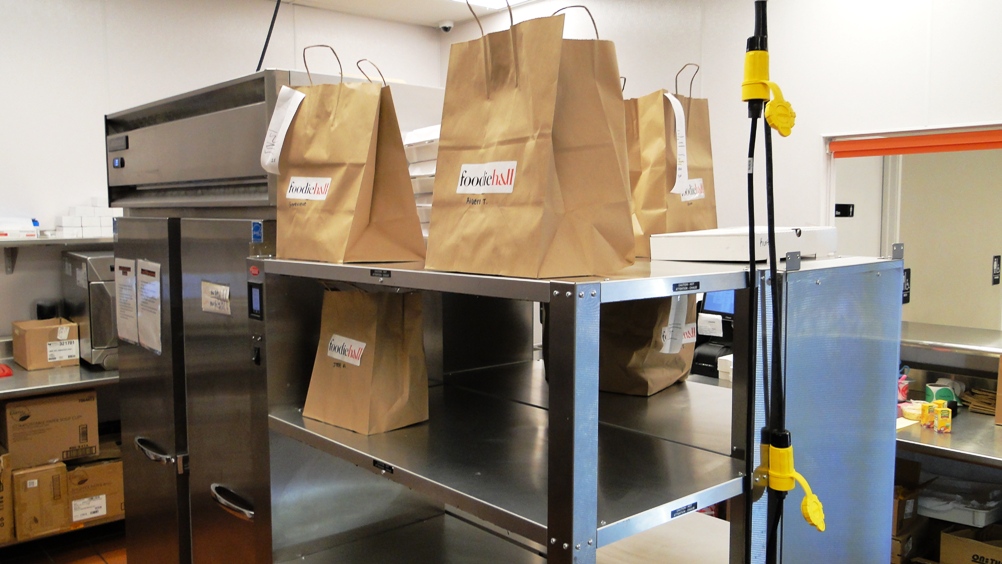
Since the pandemic, the trick is to keep food warm.
In case you’re wondering, Foodie Hall wasn’t conceived during the pandemic. But the sudden pivot towards takeout and delivery definitely gave the idea a boost.
“In 2018-19,” Goldberg remembers, “my original founding partner (Nick Ballias) and I, we met at a food event that I co-chair, called Men and Women are Cooking, that raises money for the Atlantic City Boys and Girls Club. This was when GrubHub, Uber Eats and DoorDash had come to Atlantic City, and it was starting to blow up.
“We started coming up with an idea for a delivery-only restaurant. We had penciled this out already, and then Covid hit and restaurants closed, and all of a sudden everyone was ordering delivery.
“My parents were telling me how they had ordered Morton’s for dinner. That’s when it struck me, there are people whose consumer habits have now changed and will never go back. It’s no longer just wings and pizza. There’s my parents, who are not exactly the most tech savvy, ordering steaks for dinner, that means anybody can be ordering everything.
“So why not come up with a restaurant concept that had multiple different types of cuisines on it? We ran into this family idea, where the parents want adult food and the kids want pizza or mac and cheese. Or the parents can’t agree. Or you have a group of friends watching football and they all want something different. Rather than settling, let’s have something for everyone.”

The conveyor belt. It seems so obvious if you’ve owned a dry cleaning business.
Sounds great, but how could that all work? A conveyor belt is a big part of it (!), but Goldberg says every step of the process matters.
“We put a lot of thought into what delivery trends were taking place, what was working and what we saw that wasn’t working,” he remembers. “Packaging was a big piece of it. Many restaurants during the pandemic that were doing delivery kind of out of necessity were using takeout packages. Those packages are not meant necessarily to be reheated, or to be leak proof, or to sit in a car for half hour or to retain heat or cold.
“We looked at packaging specifically meant for delivery. We wanted something that would maintain heat and not leak. We literally made products in our kitchen, put them in different containers, and had them sit in our parking lot for half hour or drive around and see how they held up. We wanted packaging that would be eco-friendly, and also able to be reheated in microwaves and ovens and things.”
Then there’s the little matter of creating a wide variety of cuisine from one kitchen, maintaining quality, and somehow keeping overhead down.

Some ingredients are astoundingly versatile.
“We are very conscientious in the ingredients we use to be cross-utilized across all the platforms. For example, chicken breast is used in multiple products across the different restaurants. I have a chicken parm sandwich at Criss Crust, and we have the chicken sandwich concept, Simply Fowl, and then we have salads that have grilled chicken on them. We’re trying to use things across and that keeps us more efficient.
“When we designed the kitchen, we were concerned with having a traffic issue, with people walking around and bringing all the various foods to the front. It would have been a waste of labor. We came up with a solution which I borrowed from my old business…a commercial laundry business…where we had a conveyor belt. It’s a 120-foot conveyor belt that runs down the center of our kitchen.
“I don’t need people running up to the front and bringing the food, I don’t have to worry about people walking into each other. It’s a way to keep costs down and keep order in the kitchen.”
The conveyor belt concept is indeed impressive to witness. An owner of a busy diner might see it and wonder how in the world they didn’t think of it.
“No one’s ridden on it yet that I know of,” Goldberg jokes.

Craft burgers. Just because craft burgers.
JerseyMan loves telling readers what makes life in South Jersey great and highlighting business ingenuity among our own. Places like Foodie Hall give us plenty to work with.
In the days before smartphone maps, you might have had a difficult time finding the place. It’s situated in an industrial park in Cherry Hill, just off of Route 70 but requiring navigation of annoyingly tricky jug handles and intersections. If it were a sit-down restaurant, the difficulty getting there might be a factor in your going elsewhere.
But for this style of eatery, the location is the beauty of it.
“We are delivery and takeout only,” Goldberg says. “We need to be near people, and we need to be near businesses, but I don’t need to be on Route 70 or Route 73. I just need accessibility, I don’t need visibility. We built out this really high-end large kitchen, with the latest and greatest in equipment, but I’m not paying the prices I would pay to be on Route 70 or 73. It’s more economical to be here.”
Market research drove the location of Foodie Hall’s first outpost in Cherry Hill. Even though it seems obvious.
“Between Cherry Hill and Mount Laurel and Maple Shade, you have a tremendous number of people that are foodies. It really fit well for us.
“It has a great mix of residents and businesses. We can cater to people in their homes at nights and weekends, and our concept lends itself perfectly to office orders and catering during the day. We’re getting a lot of offices that typically order once a week, same idea as from home. Instead of having 20 people fighting over what we’re having for lunch, now 20 people can get what they want in one delivery.”
Including an authentic Geno’s cheesesteak, without the tolls and traffic.
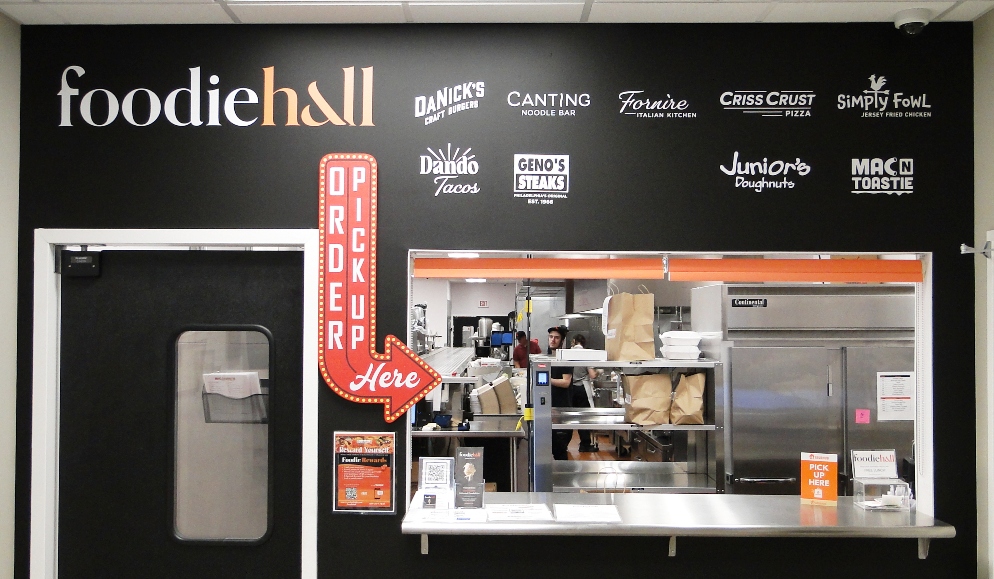
“Wow, you can get DaNick’s here?”
Establishing The Brand(s)
Foodie Hall features eight restaurants under its umbrella as this sentence was written, including Geno’s Steaks, an instantly recognizable brand to Philly area natives.
You can order Mexican street cuisine from Dando Tacos, Jersey fried chicken sandwiches from Simply Fowl, craft burgers from DaNick’s, Buffalo chicken mac and cheese from Mac N Toastie, or vegetable dumplings from the Cantina Wok & Noodle Bar. If you’re going Italian, try the Criss Crust Detroit-style pizza, or the antipasti from the Fornire Italian Kitchen.
Seeing the choices, a South Jersey food enthusiast could wonder how they have lived here so long without recognizing the catchy names and logos sitting alongside Geno’s. How does anyone miss Mac N Toastie?
When questioned whether the others are established eateries in their own right, Dan Goldberg considers it a triumph of Foodie Hall’s design.
“I’m glad you asked that,” he explains, “because they’re not. The fact that you asked that question means we did a good job of branding and trademarking to look like they are established brands. And the idea is that these brands will proliferate and open up in other Foodie Halls.
“There was a lot of thought given to the name, the logo, the design, the color scheme, to make it look like a franchise or an established restaurant. But they’re all our own creations, we came up with them. We put the menu together, the recipes, etc.”
That includes DaNick’s, which sounds perilously close to DiNic’s, the long established roast pork sandwich destination in the region.
“No, different name,” Goldberg responds when asked about the similarity. “They’re actually named after (co-founder) Nick (Ballias) and I, Dan and Nick. Nothing to do with them, we love their sandwiches, but yes, completely unrelated.”
So foodies in the area can rest easy knowing that they haven’t missed out on Fornire’s, and a potential topic for their blog.
But if you’re one of those types, the clock’s ticking on trying out Foodie Hall before your blogosphere competitors do.

You’re probably pretty good at cooking if you’re seen with this guy. (photo courtesy of Georgeann Leaming)
Key Players – Georgeann Leaming
Dan Goldberg and co-founder Nick Ballias don’t mess around when it comes to takeout fare for discriminating South Jersey natives. While working out the plans for Foodie Hall, they considered product quality important enough to bring a chef on board to be a culinary consultant, and design recipes for their menu of food creations.
Not just any chef, by the way…they partnered with Georgeann Leaming.
You may have heard of Leaming…she’s been a champion TV chef on Food Network’s Chopped, and competed on Hulu’s Man vs. Master. She’s been an executive chef for two of Gordon Ramsey’s restaurants, and has co-owned two food stops in Philly. One of them, Samwich, took Philadelphia Magazine’s “Best Fried Chicken Sandwich” prize in 2016.
That’s just a partial list of Leaming’s street creds in Philly area cuisine, but it’s enough to see why Dan and Nick would take the opportunity to work with her.
“It was very important for us to not simply have your average burger or chicken sandwich. We try to do everything higher end than your normal delivery would be.
“She left to pursue some other avenues in September, but she was with us all the way. She helped us design the menus, and some of the dishes were completely her own from top to bottom in terms of the ingredients, the recipes and everything. These are recipes that we use, and we haven’t changed anything since she left.
“Georgeann was a big help,” Goldberg acknowledges. “Fantastic, talented chef, culinary director, and really helped design and get this to where it is. Perfect person for this, and without her, we wouldn’t have the type of food that we have today.”
The decision of what to get for everyone in the room isn’t the only comestible conundrum Foodie Hall solves. If you’re looking for cuisine inspired by a top chef in the region without the triple-digit price, they take care of that for you too.
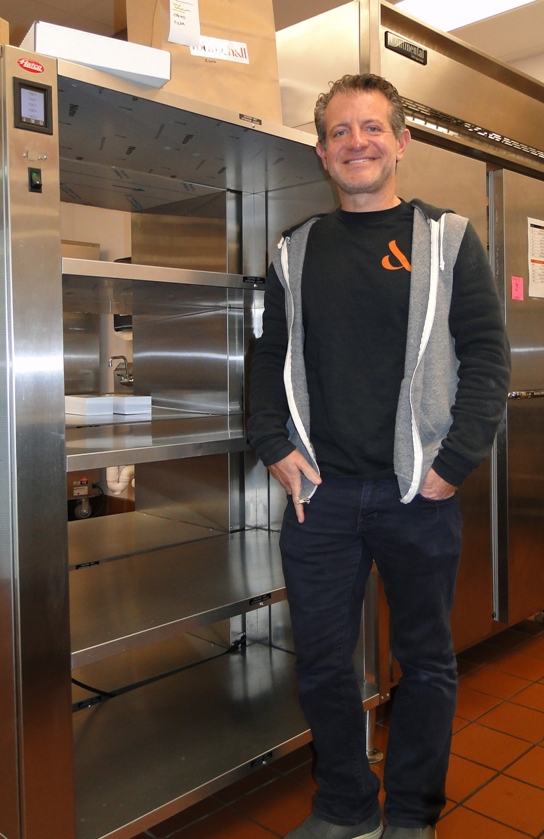
Dan Goldberg, FoodieHall co-owner, feeding people everywhere.
Meals 4 Meals
Dan Goldberg and his people consider giving back to be part of the ethos of business success, and they offer an incentive to philanthropic types who love great food. For every meal ordered from Foodie Hall, they donate a meal to Feeding America through their Meal 4 Meal program. On Foodie Hall’s website, they call the initiative “a vitally important guiding principle in how we operate.”
Goldberg is happy to explain how it works. “What they do is, they will take a monetary donation that they get a lot more mileage out of than we would, because of their immense buying power. We donate an amount to them for every meal that we sell, which is the meal equivalent for them. They use that to purchase meals for their partner charities, which are all across the country and the world.
“We initially got the idea from the Bombas Socks people. For every pair of socks that they sell, they donate a pair to people in need in a country outside of America. And we loved the idea. It made a lot of sense to us.”
So when you order from Foodie Hall, you’re not only providing all your guests or employees something for their own tastes, you’re making a contribution to a four-star organization with 200 food banks and over 60,000 programs to help feed the hungry in your own homeland. Not that you need any extra incentive to try Simply Fowl’s Nashville fried chicken sandwich, but it doesn’t hurt.
“By our calculations,” Goldberg estimates, “We’ll be donating about 50,000 meals in this year, which is really exciting. I’m very proud of that.”

The Resilient Reading Terminal Market

The Reading Terminal Market in Philadelphia had its struggles in 2020, so JerseyMan and I gave it some well-deserved props for the January 2021 issue. You can see it on JerseyMan’s website here, or see the magazine article here.

The Resilient Terminal Market
The Reading Terminal Market was hit hard by the pandemic, losing over half its foot traffic throughout the tourist season in 2020. The merchants, locals, and even some outsiders came together to help keep the lights on, but the quality of the goods is ultimately what keeps the Market going.
A visit to the Reading Terminal Market is well worth any travel expense and hassle, but it always presents an exasperating conundrum:
“What the hell am I gonna eat?”
Human stomachs are insufficiently sized enough that in every trip to Philly’s venerable marketplace, it’s impossible not to miss out on something amazing. It’s particularly rough for tourists, who may only manage one or two visits.
The Market sometimes seems to cause more culinary heartache than pleasure. Sure, have one or three of Beiler’s doughnuts…but unless you have a committed sweet tooth, that means foregoing Dutch Eating Place apple dumplings, Flying Monkey whoopie pies, or Termini Bros. torrones.
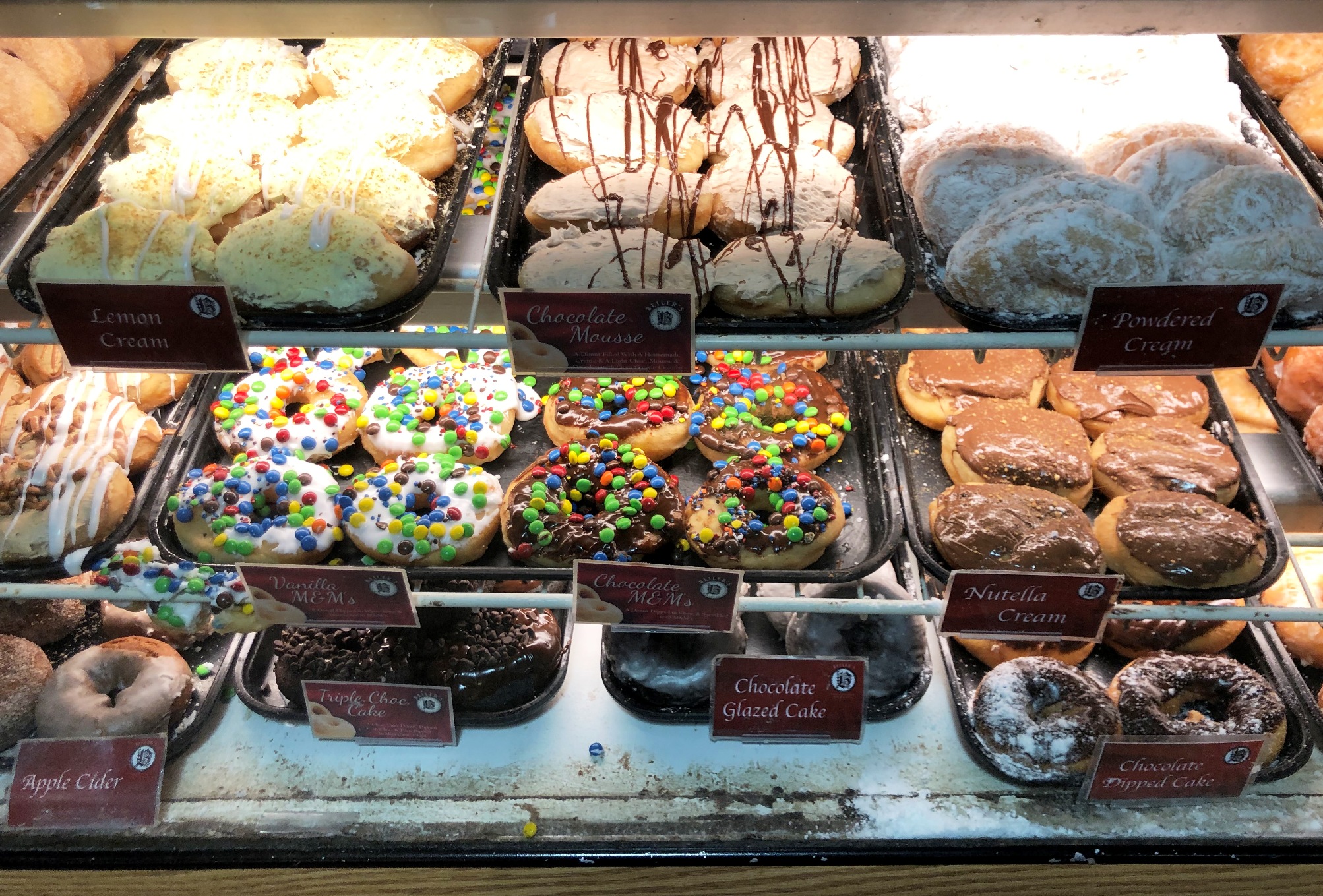
Sorry, what were those other choices again?
If you’ve ever experienced this distress, you’re not alone.
You’d think the Market’s general manager would have sound advice for this situation, but unfortunately Conor Murphy isn’t much help. Murphy visits the Market every day, and even he struggles mightily with the question.
“There’s just so many great sandwich options,” he says. “You’ve got a fantastic sandwich at Smucker’s, DiNic’s is obviously incredible. I’m an unapologetic carnivore, but there’s great sandwiches too at Luhv Vegan. Whether you want a chicken sandwich or a beef sandwich or a fresh deli sandwich…Hatville Deli does a great job…there’s just too many choices almost.
“It can be a challenge sometimes to choose your lunch. Phenomenal options, the classic Philadelphia specials, and also obviously great healthy options too.”
London Faust is the digital media manager at Bellevue Communications, the firm that manages the Market’s PR. She is a bit more willing to risk choosing a go-to vendor; she recommends Olympia Gyro.
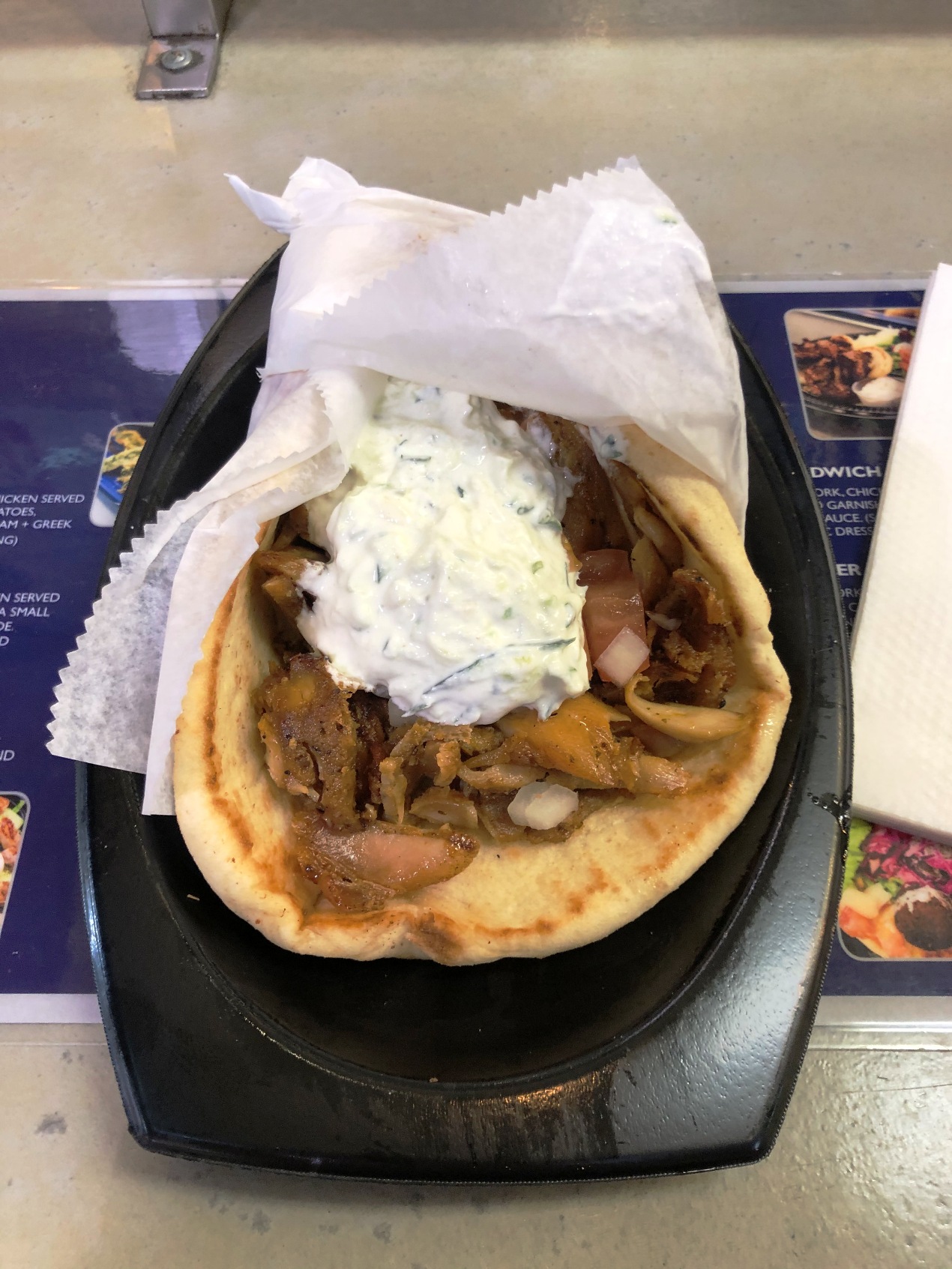
Just for the record, she’s right.
“It’s well balanced and a good bang for your buck,” she shares. “Their gyros are really good and fresh, and don’t fill you up to the point where you’re so uncomfortably full, but they also have the biggest, freshest salads I’ve ever seen.”
Okay, that helps a bit. Murphy also offers a small but valuable piece of advice: Don’t look over your shoulder.
“Sometimes if you’re standing at DiNic’s, and then you look over your shoulder and you see Hershel’s, well then suddenly the decision just became much harder. You go to Olympia where London likes to go, and you turn over your shoulder and there’s Kamal’s.
“You kind of have to come in with your blinkers on almost. Make your decision and get it done. Because if you turn your shoulder, you might have to change your mind.”
This extreme gastronomic agitation is the true appeal of the Reading Terminal Market. For locals, the substantial selection of food staples keeps one returning, again and again. For frustrated tourists, it may inspire a better-planned return visit to Philadelphia. The Market is equal parts tourist attraction and favorite local destination, and it does both very, very well.
That balance has been key to its survival in the toughest of times. Which 2020 unquestionably was.
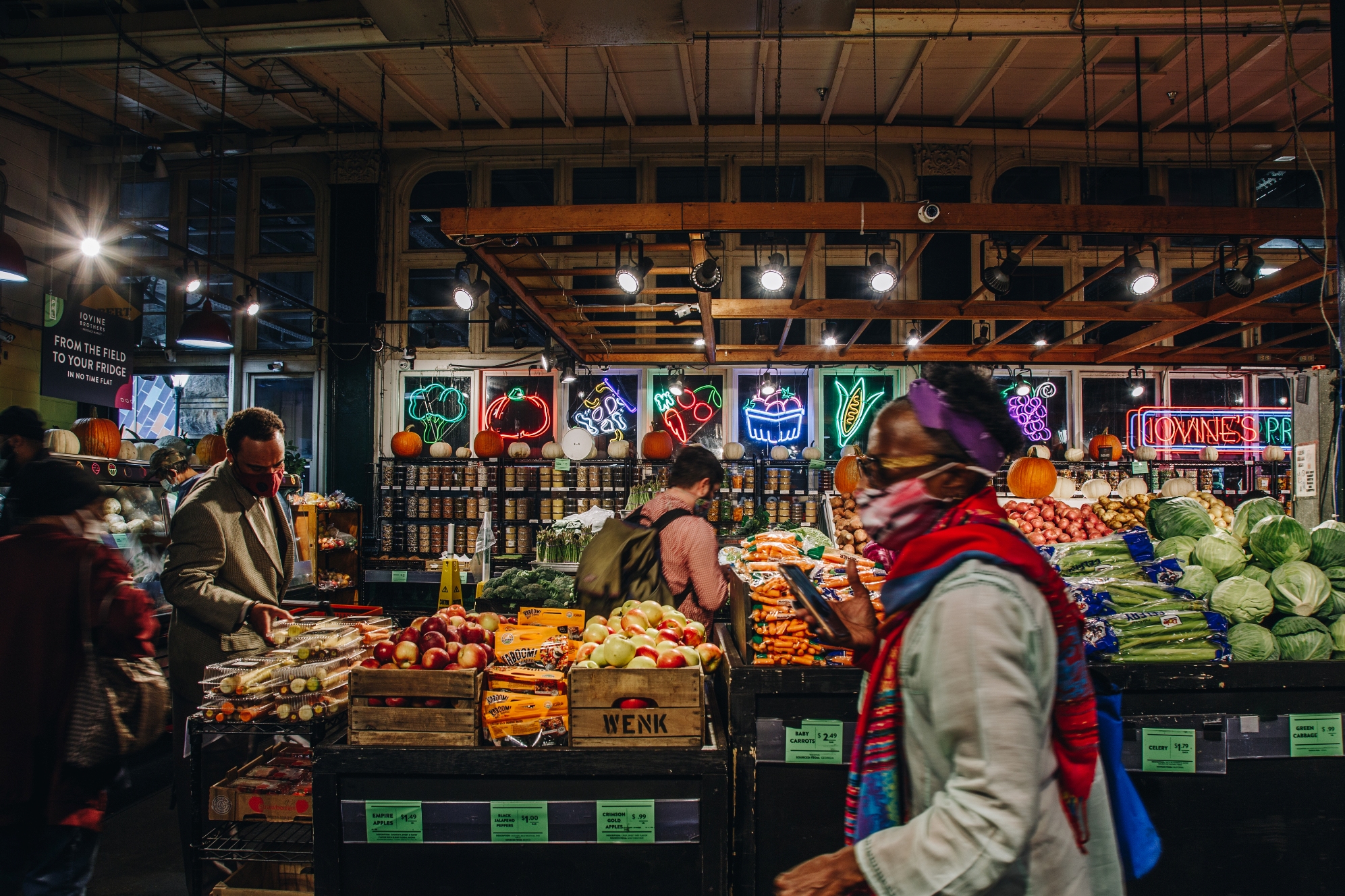
We will get through this, for the Market’s sake.
(photo courtesy of the Reading Terminal Market)
Throughout the history of the Reading Terminal Market, it seems to have been positioned to survive world instability. That doesn’t just include a depression and two world wars. The Market has weathered other storms too, like the decline of the railroad industry.
The “Reading Terminal” part of the name comes from its location, as a key hub for the Reading Railroad. The rise of the automobile drove the Railroad into bankruptcy by 1971. The Reading Company remained overseeing the Market, but they instituted higher rents for already struggling merchants, driving many of them away.
Decline and crumbling infrastructure continued until the Convention Center Authority purchased the Market in 1990. With that deal came $30 million of public funding for upgrades. To secure that kind of cash, you’ve probably got some clout with the locals.
So where does a worldwide pandemic rank among the tribulations the Market’s endured in its 128 years?
It’s probably top three.

People never stay away from Bassett’s because of the quality of the ice cream.
“The Market has been through a lot,” Murphy says. “But I’m looking back through history, talking to different merchants and historians, and there’s a general sense that this is certainly up there with those past experiences.
“Usually from April through Thanksgiving, food and beverage options around the city get a lot of foot traffic. On a Friday or Saturday the Market would have anything from 35-40,000 people a day coming through. This year, it was anything from 55-60% drop in those numbers.”
The difficulty of social distancing in a tight city venue doesn’t help. “As an old train station, you can imagine the building is equipped for lots of people coming through,” Murphy adds.
Like every establishment in the country, the merchants have had to adapt to survive. But just as every difficult period in our history has revealed the strength of the Market, the challenging times caused folks to rally behind Philadelphia’s favorite food destination.
Even from as far as Boston.
As efforts grew to help the Market stay operational, including adding a GoFundMe page, it attracted the attention of Dave Portnoy, founder of Barstool Sports. Despite being a Beantown area native, Portnoy is a Philly food enthusiast and passionate about supporting the cause. He arranged for Penn National, the owner of Barstool Sports, to donate $100 for every $100 deposit made by fans in the Barstool Sportsbook app.
It was a significant factor in the GoFundMe campaign’s success, which has totaled $211,597 as this sentence was written, contributed by 4,773 Market fans. The funds will be enormously helpful for day-to-day operations.
“Since the beginning of the pandemic,” Murphy explains, “we’ve offered support to merchants in the form of rent deferments. One of the other things that we do a lot is events, and we are able to cover a lot of our costs through some of those events. So without the events, and with some deferments in place for merchants, we wanted to make sure we were able to remain available and open seven days a week.
“Simple things, being able to pay utility bills, and all the extra sanitation costs that we now have to keep customers safe.”

Keep the lights on for Hershel’s sandwiches.
Murphy is overwhelmingly appreciative at the reminder of how beloved the Market and its peddlers really are.
“The Market has such an incredible presence for everyone that lives in the city,” he says. “Some of the personal stories were really, really fantastic. I think ultimately the Market is here because of Philadelphia, and because of the loyalty that shoppers have to us.”
Speaking of what he calls the camaraderie and spirit of the Market, you can hear the emotion in Murphy’s voice.
“With the essential service designation for public markets…nobody at the Market had to be told what that meant. They all just love to serve people. They fundamentally understand what it means to serve customers.
“I grew up in a small business in Ireland. People who run small businesses, they’ll always be my first heroes. They’re just fantastic people, you know, they really are. Small business is so, so important, especially now.
“I moved here six and a half years ago, and it’s amazing to see how people have been so supportive. It’s fantastic to see Philadelphians wanting to support the Market so much.”
Faust shares Murphy’s reverence for the outpouring of civic pride. “The Market’s really a family,” she adds, “and it’s really heartwarming to see everybody support each other.”

By George, I think I’ll have some pizza!
While 2020 was as tough on our favorite marketplace as it was on everyone, the difficulties may ultimately become growth opportunities. Murphy says merchants have greatly improved their ability to take online orders and deliver the goods for hungry fans. The virus may have revealed how much these iconic vendors underestimated their popularity outside of the building.
“We have worked really hard to get people onto delivery platforms. We’ve got a great partner, Mercato, that helps us on the food delivery side. Then the lunch counter merchants, trying to pivot their businesses to delivery apps, the Caviars and the Doordashes of this world.”
Murphy admits, however, that the ability to order delivery from so many wonderful vendors can’t match actually visiting a Market so abounding with edible excellence that you can’t even look over your shoulder. That exasperating whirlwind moment of indecision between Carmen’s and Keven Parker’s is the Reading Terminal Market at its alluring best.
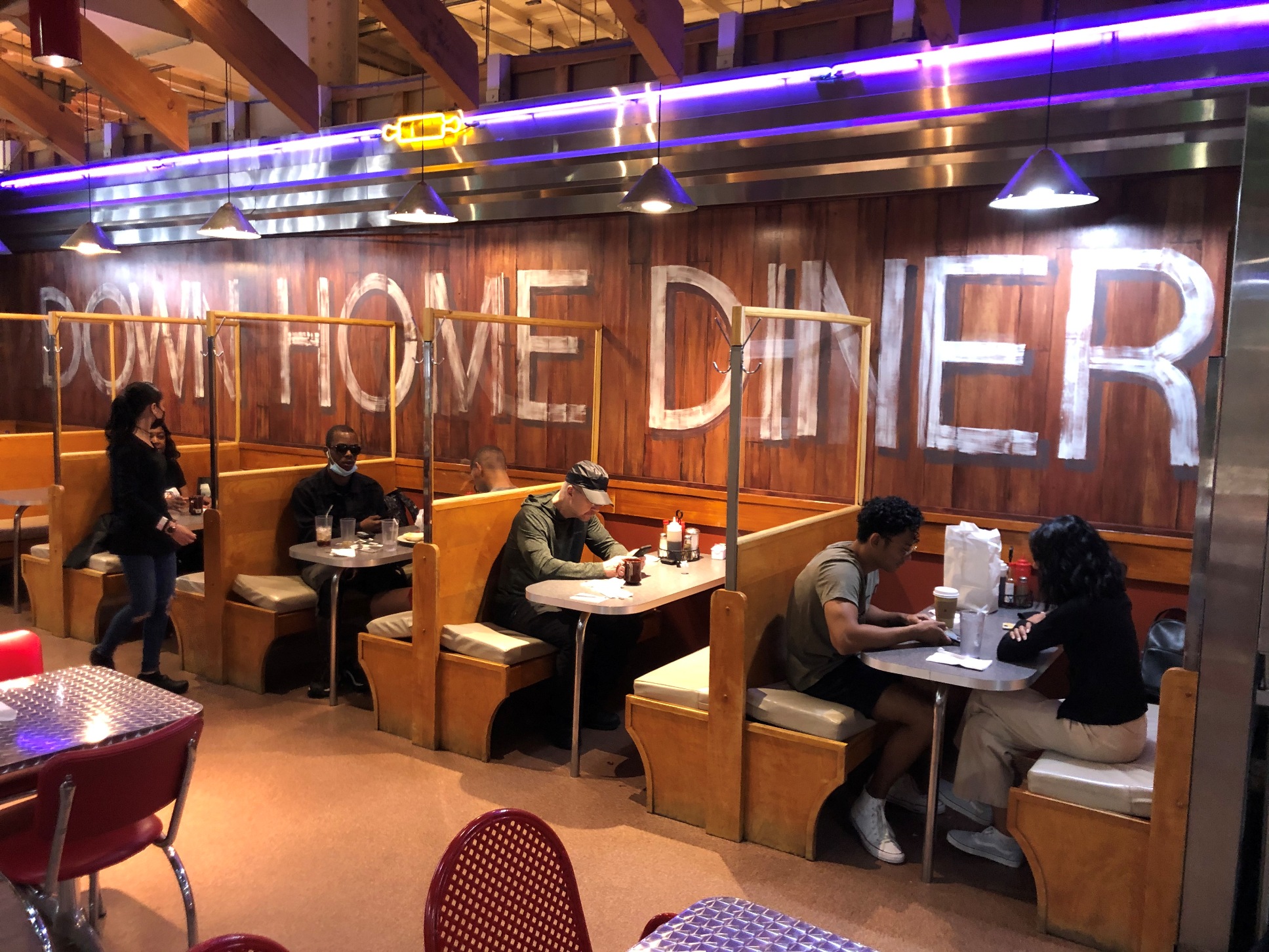
Social distancing is worth enduring for down home cooking.
“Pandemics end,” Murphy reflects, “and I think there is some light at the end of the tunnel with all the great news recently about vaccines. The best experience of the Reading Terminal Market is to come and visit us yourself. Ultimately, what we love to see here is people come through our doors to visit, because it is such a great food experience.”
That it is, even if it’s a torturous dilemma to choose from dozens of world-class eateries. Fortunately, Murphy is confident we’ll have many more opportunities to experience it all.
“There’s obviously a very clear love for the Market. That love has been built over 128 years, and our plan is to build it for 128 more.”
And Down Home Diner’s scrapple alone could keep us coming back until 2149.
Did this post make your day a little bit?
I hope so. If it did, I would really appreciate your support.
When you use this link to shop on Amazon, you’ll help subsidize this great website…at no extra charge to you.
Thanks very much…come back soon!

The Market has all you need.
(photo courtesy of Carolyn Wyman)
The Market Sampling Tour
The Taste of Philly Food Tour people can help you a tiny bit with the agonizing challenge of what to get at the Market. You can book an inexpensive tour of the Market on Taste of Philly Food Tour’s website, although as of this writing tours are still suspended.
Author Carolyn Wyman runs the site and tour, and she knows a bit about food in our fair city. She’s the author of The Great Philly Cheesesteak Book, the definitive guide to classic vendors of Philly’s signature sandwich. The very well done book even mentions 2004 presidential candidate John Kerry’s costly cheesesteak faux pas.
The tour is not actually through Philadelphia but is simply a tour of the Market itself; Carolyn or one of her friends leads visitors through the Market and shares stories of its history…along with, of course, tastings.

Miller’s pretzel cheesesteak anyone?
According to Wyman, samples that patrons get to try (based on group size and dietary issues) can include:
– A piece of a Miller’s Twist pretzel
– Scrapple from Down Home Diner or Dutch Eating Place
– Snapping turtle soup from Pearl’s Oyster Bar
– Butter cake from the Flying Monkey Bakery
– Jewish apple cake from Hershel’s deli
– Butterscotch vanilla ice cream from Bassett’s
– Wilbur Buds and Goldenberg Peanut Chews from the PA General Store.
Wyman adds, “The tour definitely includes ideas on other great foods and best finds in the Market…the most popular donut at Beiler’s, the unique Philly cream cheese cheesesteak at Carmen’s, the summer-only lemon cooler cake at Termini’s etc.”
Certainly enough to assist in that blasted decision process, and samples are small enough that you’ll still have room to order a full version of what you liked the most.
The Market’s website calls it “fun history that has nothing to do with government”. Something to consider for the next field trip with the kids.
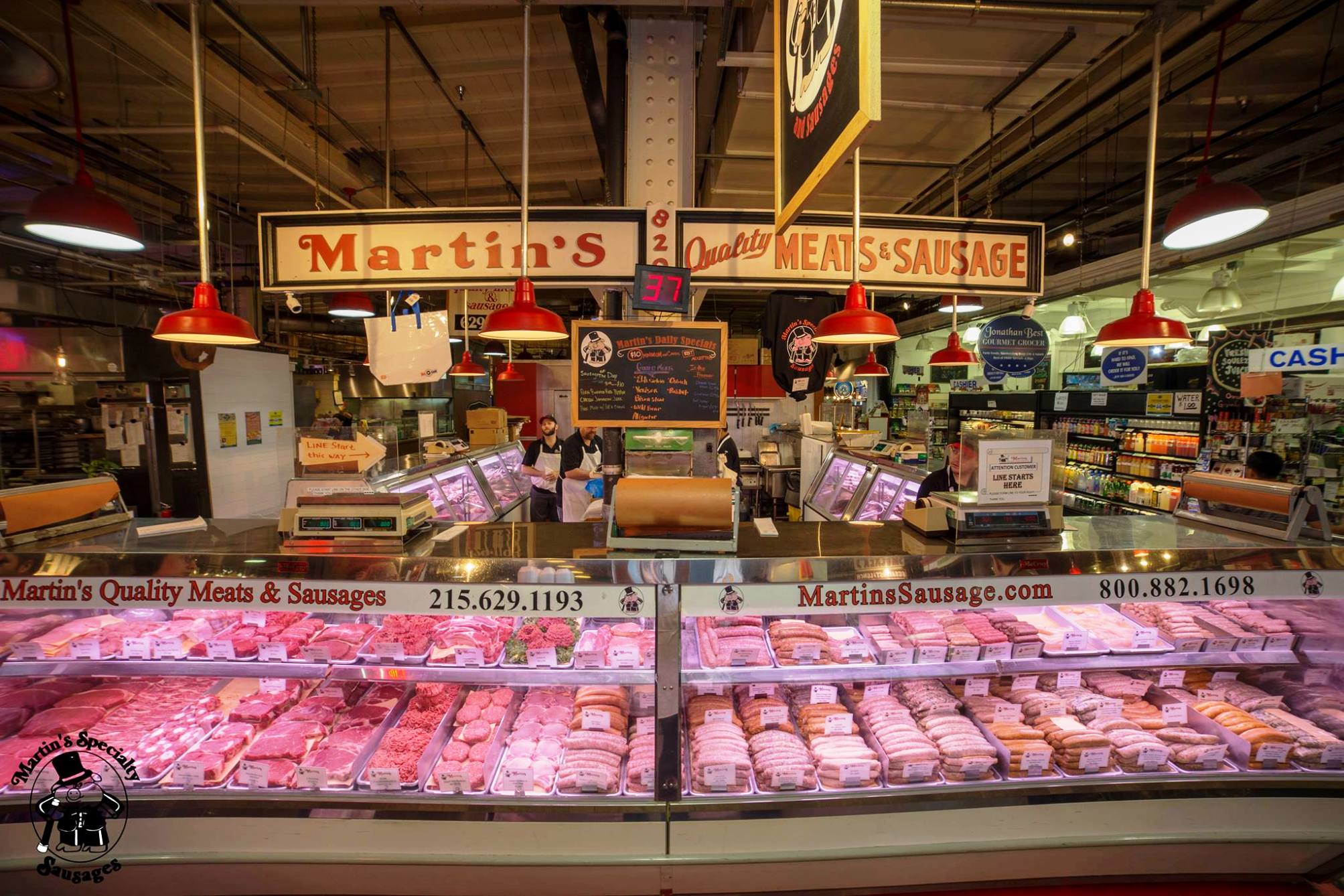
I looked behind the counter. Diane Kruger wasn’t there.
(photo courtesy of Martin’s)
A True National Treasure
The Market has made a few appearances in American cinema, most notably in the 2004 hit National Treasure.
You may remember the scene: Abigail (Diane Kruger) and Riley (Justin Bartha) temporarily escape from villain Ian Howe’s (Sean Bean) henchmen in the Market, and Abigail temporarily hides behind the counter of Martin’s Quality Meats. The woman working behind the counter, after initially informing Abigail that she doesn’t belong there if she’s not a steak, lets her stay believing that she’s running from her ex-husband.
The movie crew brought in close to 50 extras to pose as customers (the woman behind the counter was an actress named Sharon Wilkins) and spent 14 hours on two Sundays filming the scene. Gabrielle Giunta, daughter of Martin’s owner Martin Giunta, told JerseyMan about it.
“The market was closed on Sundays, and they asked us to open and set the case on a Sunday to do the filming. The producer put an actress behind the counter for ‘customer service’ and they had to film the scene a bunch to get it right.
“A lot of people did ask us about that in passing – was pretty cool as a kid to hear people ask my dad about being in National Treasure.”
The chase scene, like the rest of the movie, turned out superbly. But the movie makers seriously screwed the pooch on feeding the crew. They brought in a trailer from an outside caterer, rather than letting the crew dine on the countless offerings from the Market itself.
If you’ve never seen the movie, you can view the scene on YouTube. (But check out the whole movie…it’s good.)
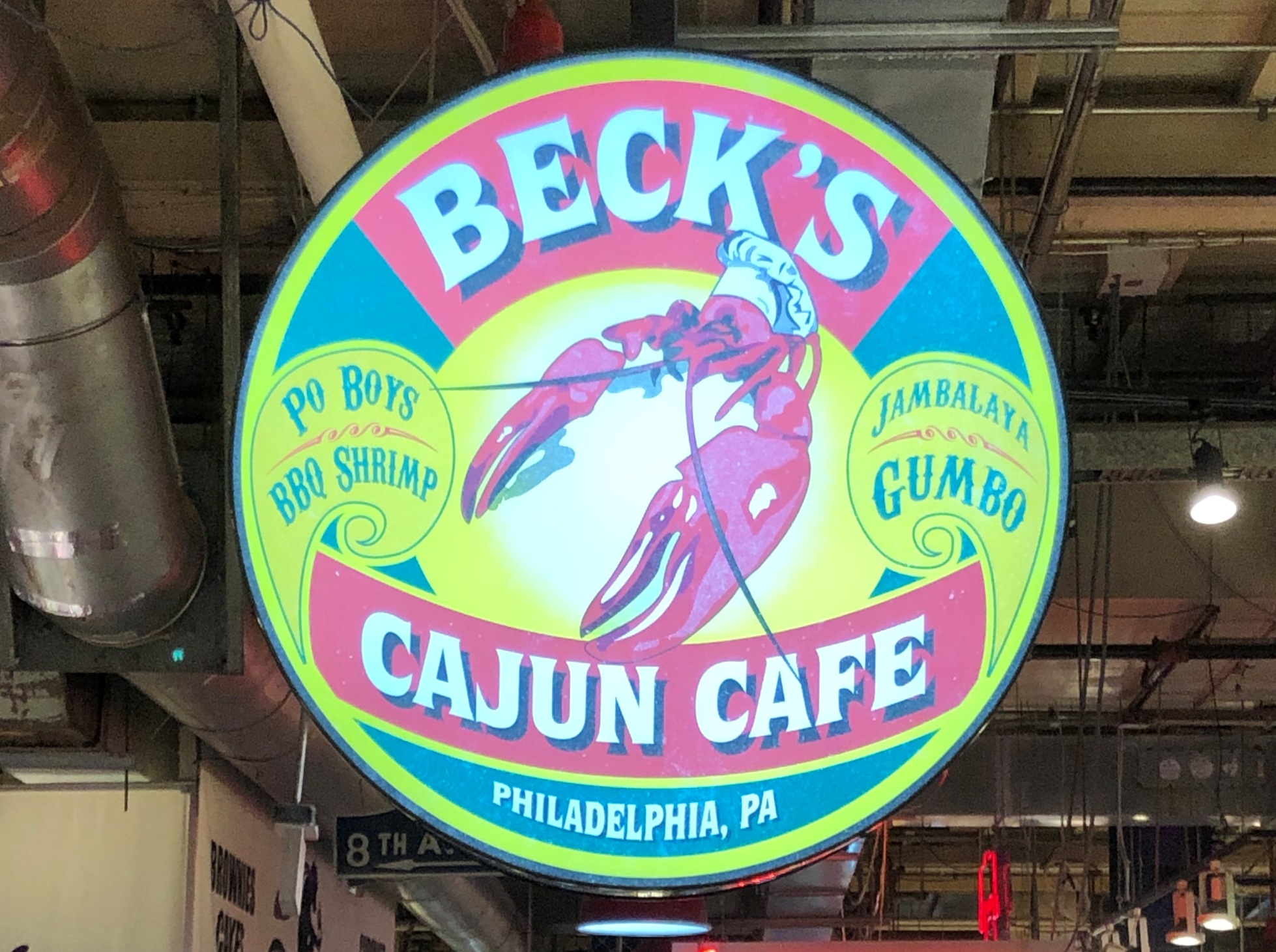
Now delivering to your area!
Bringing The Market To You
As Conor Murphy points out, the Market has partnered with Mercato, the online grocery delivery service. Thanks in part to the pandemic, you can now order food from most any Reading Terminal Market merchant, and have it delivered within a reasonable radius.
Be warned; the process of choosing isn’t any easier…but at least you can take some time to think about it. The merchants’ logos are featured in a rotating slider, enabling you to choose one and view their delivery offerings. Order a blackened chicken platter from Beck’s Cajun Café, a vegetable lasagna from By George, and a pound of smoked wings from Dienner’s. Add three chocolate swirl banana puddings from Sweet Nina’s for dessert, and you’ve got a few days’ worth of fantastic food in the comfort of your own digs.
It’s not cheap; the shopping excursion just described will set you back just over $75 if you’re sending it to Turnersville. But it spares you the gas, tolls, parking, and travel time, and Mercato will bring the fabulous flavors of the Market to your front door. Mercato offers discounted delivery when you join their Green service.
It’s a great way to experience the Market without leaving your home, which, as we’ve all recently learned, is something that could afflict anyone.
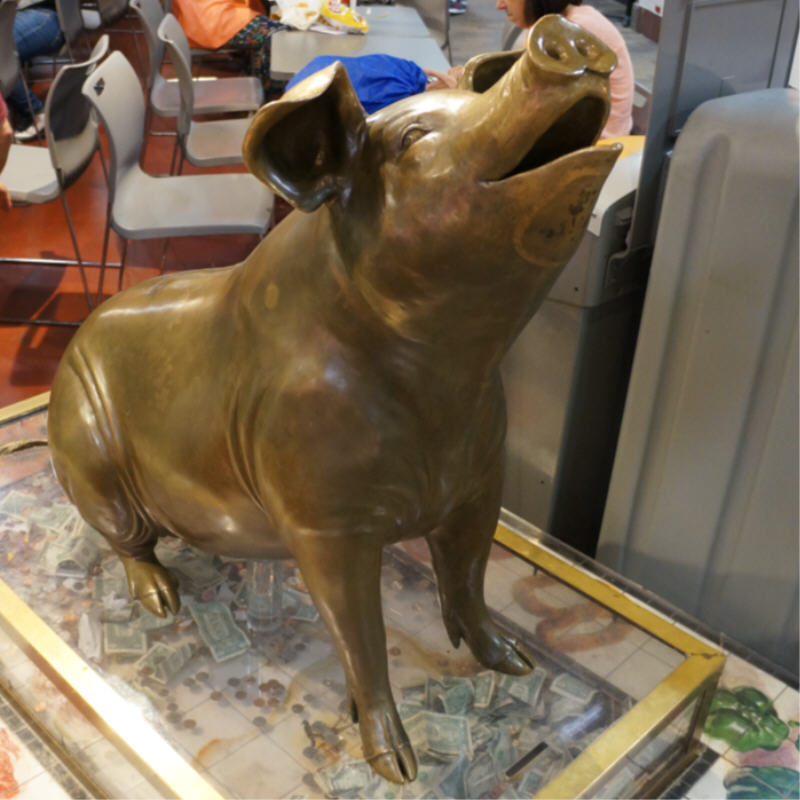
The ever-pleasant Philbert, collecting money for the hungry in Philly’s favorite food market.
(photo courtesy of London Faust)
Philbert, The Reading Terminal Market Mascot
If you’ve visited the Market, you may or may not have noticed Philbert, the life-sized pig statue that sits on a box of coins in the center of the market. Philbert is named for Filbert Street, one of the streets adjoining the Market.
Philbert was sculpted by Eric Berg, who passed away of heart disease in May of 2020, at the age of 74. Other Berg structures in the city include the Drexel dragon, the panda at the Children’s Hospital, and the African Warthog at the Philadelphia Zoo. You can view his impressive body of work here.
In addition to being a popular Market meeting spot, Philbert is in fact a piggy bank; visitors can drop coins in its mouth, which eventually lands in the glass box on which Philbert sits. The money in the box is then donated to a different charitable organization each month, as determined by the Philly Food Trust.
You can rub his snout for good luck too, as many do; maybe it will help you make that all-important food choice at the market.
Source: Atlas Obscura

Wildwood Roller Coasters

When it comes to Wildwood roller coasters, you shouldn’t exactly expect Six Flags-level entertainment, but Wildwood is more equipped for coaster thrills than any other Jersey Shore town by a long shot.
The Morey’s Piers people have done a fine job seeing to that, building large entertainment areas on each of their three Wildwood boardwalk piers, with coasters, water parks, haunted houses, and go-karts. And it’s definitely super cool to ride a coaster overlooking the ocean.
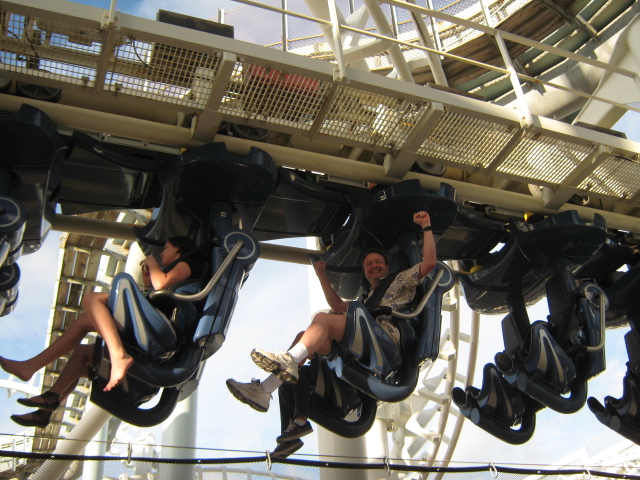
The esteemed author of A Great Number of Things approves of Wildwood’s Great Nor’Easter coaster.
There are three larger-sized Wildwood roller coasters (and some smaller ones for the younger kids), and you can get a day pass to ride all of them. Again, they aren’t Kingda Ka or the Top Thrill Dragster, but they’re pretty good, and the best part is that they are all very different in structure and thrill.
So here’s my thoughts on the Big Three Wildwood roller coasters:

The Great Nor’Easter was even cooler when it was red, but it’s still a badass ride.
Wildwood Roller Coasters #1: The Great Nor’Easter – The Great Nor’Easter looked cooler when it was painted red in my humble opinion, but the ride is just as fun with white tracks. This one is on the outer edge of Surfside Pier, the northernmost of Morey’s Piers.
The Nor’Easter is a suspended roller coaster, meaning that the cars hang from the tracks rather than sit on them. This makes for wide swinging around the turns and through the loops, adding to the whoa factor. It slowly climbs to a level of 115 feet and then plunges into a 95-foot drop, followed by several loops, hard turns and a corkscrew or two before bringing riders back around. Its top speed is 55 MPH, which isn’t bad and saves fuel. It’s not a long ride, 2:05 with the long climb up the hill, but you won’t feel gypped on the thrill quotient.
The cool thing about the Great Nor’Easter is the way it just seems to be built around and through everything in the pier. The ride flies by several spots in the waterpark, and from the waterpark you can watch people screaming by you on the coaster from several platforms. At times it almost seems like riders could kick the log flume. It makes waiting in line or climbing up the steps at the waterpark much more amusing.
Click here for some point of view action…
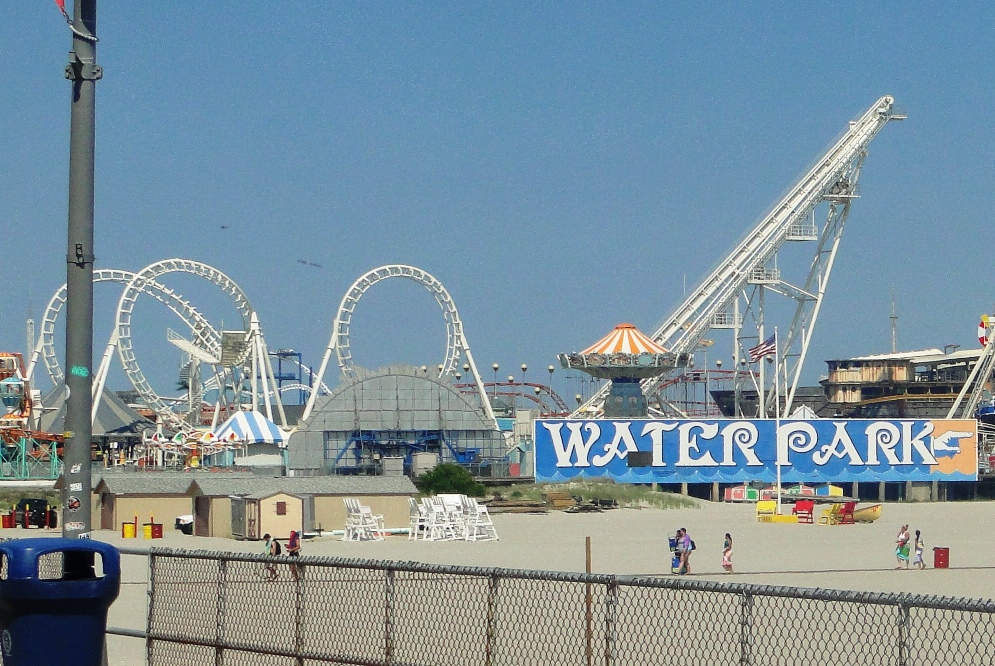
The Sea Serpent, conveniently located near a waterpark.
Wildwood Roller Coasters #2: The Sea Serpent – There are several iterations of the Sea Serpent in amusement parks that I’ve seen, so it’s not exactly a Wildwood original, but I definitely remember being intimidated by it when it first appeared on Mariner’s Landing on the boardwalk many years ago. (It was out of service at the time, that’s why I didn’t ride it, I swear!)
The Sea Serpent is unusual in being a “Boomerang” roller coaster. It starts by lifting the cars up to a 125-foot height backwards, then drops them back down, through the station, then through a loop and a cobra roll before heading up the other hill. Once the considerable momentum has carried it as far as it can go, the train lifts the cars the rest of the way, and then lets them go again—backwards. If you’ve never ridden backwards on a coaster before…it’s pretty cool.
The Sea Serpent reaches a top speed of 47 MPH. Not fast on Route 55 on the way to Wildwood, but pretty darn fast when going loudly through a cobra loop.
Click here for Sea Serpent point of view action…
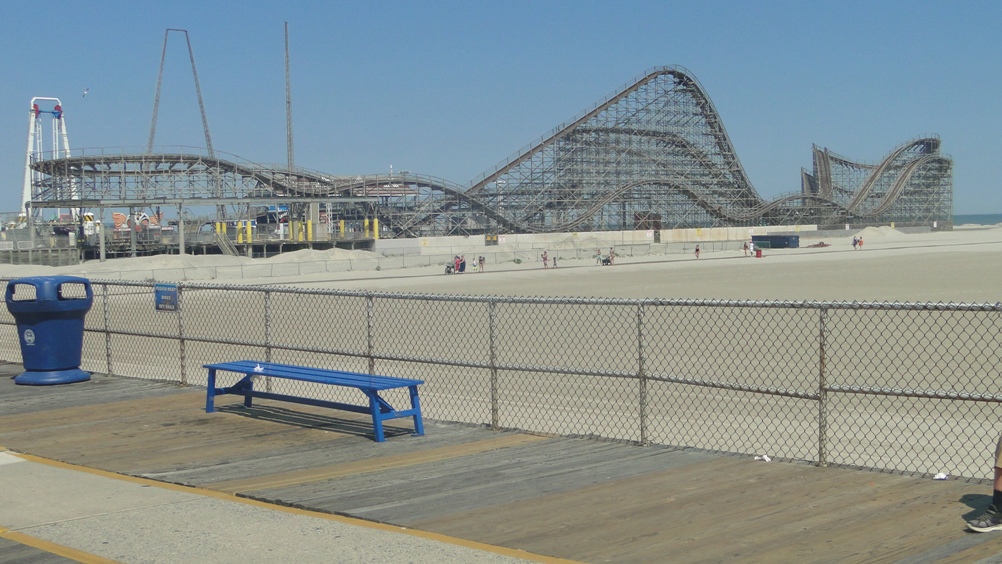
The Great White, shot from a far enough distance to get the whole thing in.
Wildwood Roller Coasters #3: The Great White – It takes a bit of a walk from the other piers to get to the Great White, which is on the southernmost Adventure Pier, closest to the Convention Center. (I believe if you get a day pass, you get free rides on the tram car until 5:00 PM or something.) Adventure Pier has definitely grown in entertainment value in recent years, and The Great White is well worth the trip. Even if it’s the only one of the big three that isn’t painted white (slaps head).
The Great White is an old-fashioned wooden roller coaster—the kind where the real thrill is wondering whether these old, rusty tracks and shaky wooden beams are going to hold the coaster while you’re riding it—not to mention those old cars with only the lap bar holding you in them. There aren’t any loops, but that first hill takes a long time and gets to 110 feet, with a steep drop to start a long ride. Great White gets to 50 MPH, which is pretty fast on those rickety tracks! Stay hydrated to help avoid the headache.
Great White has another really cool feature…at the start of the ride, there is a short 25-foot drop, and then you actually ride under the pier for a bit before going up the first hill. Very cool, especially at night, and especially if you’re not expecting it. (Which I guess you are now, sorry.)
Click here for some very cool Great White point of view action…
So there you go, your best shot at inducing bile while in the Wildwoods. All three of these coasters are well worth riding, and unlike the coasters in other Jersey shore towns, they’re big and fast enough to make it worth the trip for any coaster buff.
Did this post make your day a little bit?
I hope so. If it did, I would really appreciate your support.
When you use this link to shop on Amazon, you’ll help subsidize this great website…at no extra charge to you.
Thanks very much…come back soon!

Precision Pistol – Shooting For Greatness
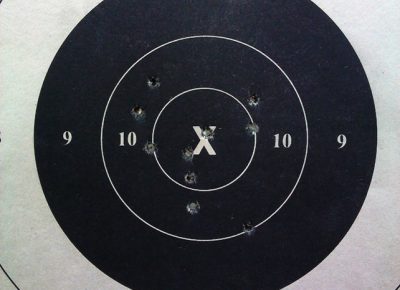
Precision Pistol shooters are phenomenal at focus…it’s quite a feat to be able to consistently nail an eight-inch wide target from 50 yards. JerseyMan sent me to cover the annual State Outdoor Pistol Championship for the December 2015 issue. I learned some amazing stuff. You can view the PDF of the magazine article here.

New Jersey’s top marksmen, shooting for nothing but excellence.
Precision Pistol Shooting For Greatness
“It’s the ultimate badass sport with pistols.”
At the end of “Rocky III”, Apollo Creed challenges Rocky to a rubber match between the two of them…to settle the score of who is the best, once and for all. As Apollo explains to Rocky, it’s only to prove it to himself…“no TV, no newspapers, just you and me.”
Because in the end, that is all that matters to a true competitor, at any level. Self-respect.
Rich Kang, a surgeon from Maryland, has had his picture added to the New Jersey Pistol website, as the Winner of the 2015 State Outdoor Pistol Championship. His name is now engraved on the Madore Trophy.
And that’s pretty much the extent of his recognition for this exceptionally difficult achievement. The top result of a Google search for “Rich Kang” is the LinkedIn profile of a California product developer with the same name.
Precision Pistol excellence isn’t something one pursues for stardom, applause or financial gain. There wasn’t much in the way of an audience or media…other than a lanky, curious writer for a popular men’s magazine…present at the championship event. Shooter Frank Greco likens it to golf: it may not be the most exciting spectator sport, but among participants, there is an unwavering admiration for the best.
“It’s the ultimate badass sport with pistols. In the shooting world, badass is snipers,” he says. “In the pistol world it’s precision shooters.”
Greco is the Regional Vice President of New Jersey Rifle & Pistol Clubs, based in Highland Lakes. A portion of this event took place at the Central Jersey Rifle & Pistol Club in Jackson. Greco didn’t participate in the competition, but he was there to explain the mystique of it, right down to the effect of donut consumption on shooters. True.
“The sugar raises the blood pressure and affects the steady hand,” Greco says, while offering a donut to this observer. “Sugar and caffeine in excess can be Kryptonite to a shooter.”
It’s that demanding?
To say the least.
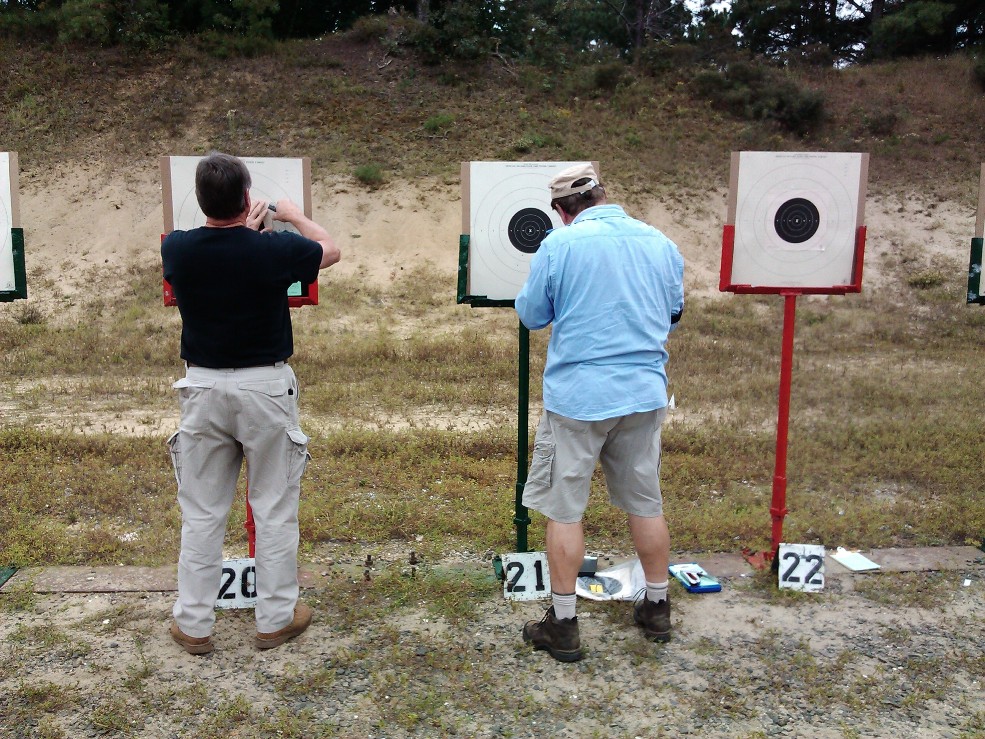
Could you hit it from half a football field away?
Picture how far 50 yards is. 150 feet. Half of a football field. Now fathom being able to steadily aim and fire a pistol from that distance and consistently hit a target eight inches wide.
That’s just for an eight-point shot. For a 10-pointer, that target is just three inches wide; for a bull’s eye…which is used as a tiebreaker if two shooters have the same score…it is just an inch and a half.
Can that even be done with normal human vision? Yes, and the shooters on the firing line this day are proving it. With multiple types of firearms and various types of shooting…moving targets, rapid fire, timed firing.
It’s a three-gun match, with .22, centerfire and .45 caliber pistols. With each type of pistol, a shooter takes 90 shots. Those 90 shots are broken down into four matches: Slow Fire is two strings of ten shots each over ten minutes; National Match Course is ten Slow Fire shots, followed by two strings of five shots each at 25 yards; Rapid Fire is two strings of five shots each over ten seconds; and the Timed Fire Match is four strings of five rounds each, with 20 seconds per string.
All day long, the barrage goes on. Casings litter the ground. Wisps of dust float from the dune behind the targets. The unmistakable odor of gunpowder fills the air. Wrists snap back in recoil with larger pistols. The noise is thunderous and deafening at times, but that’s the only aural distraction allowed. No talking or other sounds behind the line. During one match a ringing smartphone is immediately shut off; only in church could that be more embarrassing.
It’s grueling, this full day of shooting. Comfortable footwear is a must.
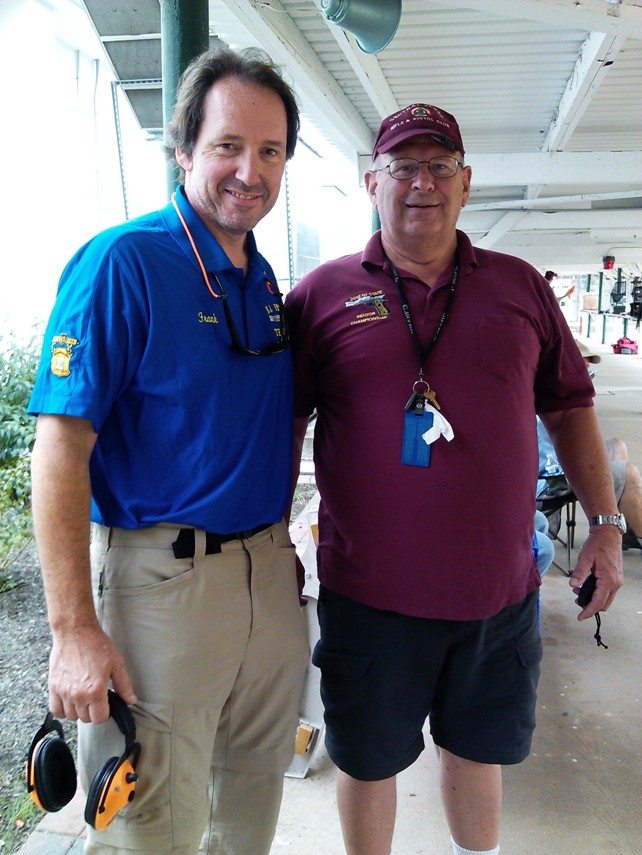
Frank Greco (left), with Ed Glidden (right), the director of the match.
Between rounds a horn sounds and a red light begins flashing. When the light is flashing, guns must be down, and must remain untouched until the flashing stops.
Ed Glidden, the director of the match, calls out instructions to the shooters, obviously with safety as the top priority. Cease fire, magazines out, make the firing line safe. Empty chamber indicators installed. Check your gun; check your neighbor’s gun. And so on, dozens of times. Glidden’s role looks boring to someone witnessing the action. But needless to say, it’s an essential one.
Part of Glidden’s occupation is training shooters in gun safety, including teaching youngsters in the club’s highly touted junior program. “Individual training,” he says, “is keeping the gun pointed in a safe direction at ALL times and treating every gun as if it were loaded. Constant awareness of the range officers and other shooters, to prevent and/or correct the slightest infraction until safety becomes a habit. Any unsafe practice will result in expulsion from the match and the range.”
The Central Jersey Rifle & Pistol Club people have a reputation for their focus on safe handling of lethal weapons. They are frequently praised for it in online reviews. It is particularly impressive to see younger people on the firing line, some barely in their teens, completely comfortable handling firearms. Partly because of Glidden’s repetitious direction, safety is second nature in this competition.
Besides, with the concentration required at tournaments like this, competitors have more than enough to occupy their minds.
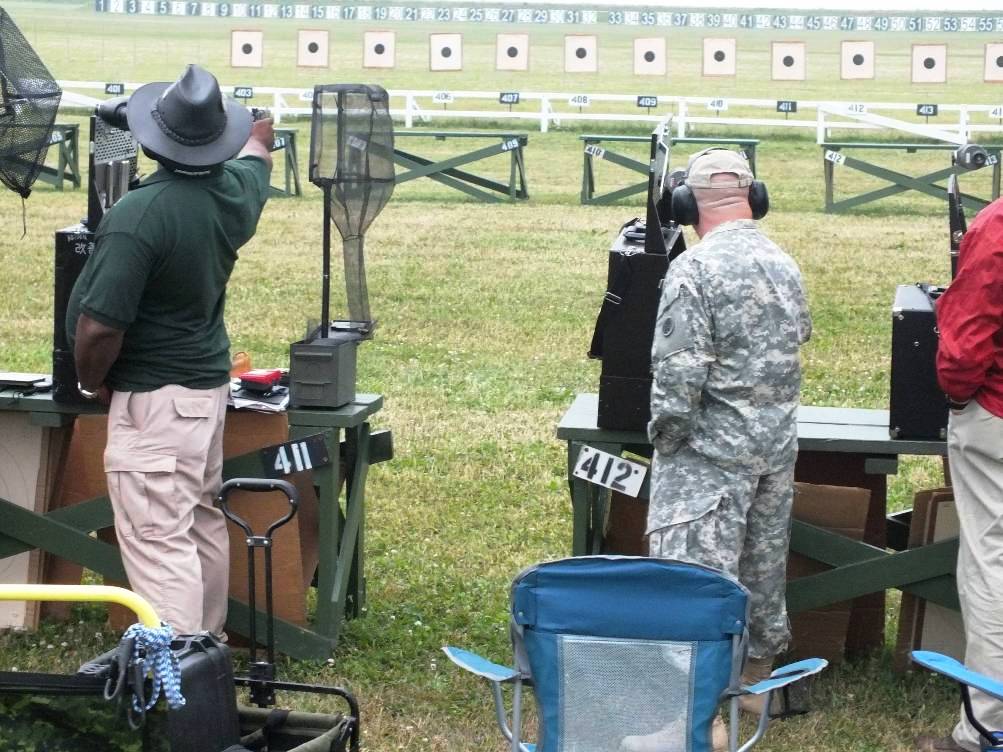
Lateif Dickerson (left), who has forgotten more about self-defense than most of us know. (photo courtesy of Lateif Dickerson)
Watching the shooters it appears as though they are cool as ice, with the focus, the concentration, the steady hand. But as one of the better shooters on the line can tell you, it takes years to develop this composure. And even he still grimaces at the occasional subpar shot.
Lateif Dickerson is the master instructor at the New Jersey Firearms Academy. His resume of other titles is very impressive: Certified Pistol Instructor, Range Safety Officer, Combat Handgunner at the School of Defensive Firearms, the list is long. He’s been training civilians, police and military for 19 years in various weapons usage and self-defense.
Dickerson can tell you a bit about becoming adept enough for this competition. There are three stages, he says…know how, physical conditioning and mental conditioning.
Know how is mastering the fundamentals… like stance, breath control, and recoil management. Stance “should be as comfortable but as stable as possible. Think like a crane; your legs are the outriggers, your arm is the boom.” Breath control is “basically holding long enough so you aren’t moving.” Recoil management is the ability to “consistently recover to the same place when shooting.”
Then there’s the physical conditioning.
“A match can go from 9:00 AM – 4:00 PM, or longer. If you start fatiguing during a match your performance will fail. You must be able to hold the weight of your arm and gun up all day – and steady. Holding steady requires an isometric tension that needs to be developed also.”
But the mental preparation is by far the toughest part.
“The ONLY thing that should exist in your mind is that your sight is where it’s supposed to be as the trigger moves rearward…this is very hard. We all have a lot of noise and distractions, so conditioning your mind to focus is a process. That process is largely the challenge in shooting.”
Frank Greco emphatically agrees, sharing a story of his own self-defeat in the mental aspect of the game.
“When you’re in it, on the line, loading, in the zone, improving your score, it’s incredibly intense and extremely difficult mentally.
“One of my first times I experienced the ‘mental game’ was in the NY State Championship. The match director came over to me and asked me if I knew I was shooting better than most of the Experts and Masters. I said no, and got accidentally sidetracked, thinking I was going to win the match. The lost focus immediately showed; my shots were random and my scores went down.
“It’s vital to maintain a positive outlook and to speak to yourself in positive statements. It’s important to train your subconscious mind and create a positive self-image.”
He pulls out his smartphone and shows this observer a picture of a target, the high-value section of it riddled with bullet holes. Sometimes, he says, he needs to look at it during a match, to remind himself what he’s capable of.

The trophy is just a bonus.
It’s all undeniably worth the effort.
The true reward of Precision Pistol, as Greco relates from his own personal experience, is self-respect…the realization of one’s hidden abilities and the ability to meet the most difficult of challenges. Once a person can hit that one-and-a-half inch bull’s eye from half of a football field away, it’s hard to imagine how monthly bills could faze them.
“Great shooters have an almost Zen-like approach to shooting and how they approach their daily lives, jobs, etc. Since I started, my ability to focus has sharpened dramatically, and it’s positively benefited other areas of my life. The ability to focus on what matters, and disregard unimportant matters, literally frees your mind.
“The benefits are real, and to that extent, shooting has made me a better person.”
Did learning about Precision Pistol shooting make your day a little bit?
I hope so. If it did, I would really appreciate your support.
When you use this link to shop on Amazon, you’ll help subsidize this great website…at no extra charge to you.
Thanks very much…come back soon!
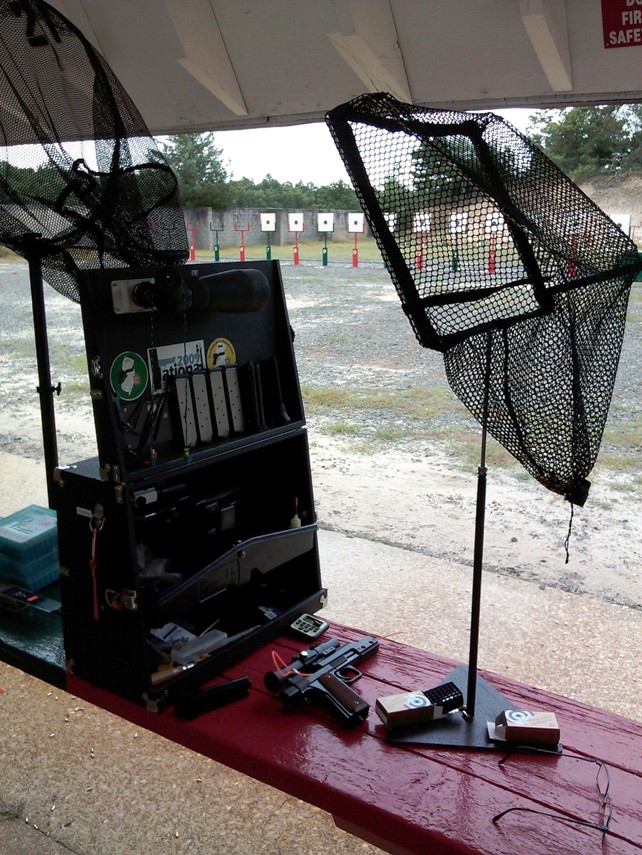
Choosing the right equipment is essential, especially with the cost outlay.
Get Started With Precision Pistol Shooting
If you’d like to try Precision Pistol Shooting, there is a website dedicated to helping you get started, with several informative pieces from top shooters. The site is called “The Encyclopedia of Bullseye Pistol”.
Among the articles is a piece by site owner John Dreyer about essential equipment. There’s a lot to know when laying out the considerable funds for pistols…like whether they are mass-produced or hand built, or the differences between high performance and convertible pistols. Not to mention other necessary equipment, like eye and ear protection, scopes and cleaning supplies. Pistol shooting is not a cheap sport, so spend wisely.
Another piece by Dreyer quotes several Zen philosophies and describes the achievements in pistol shooting in how they relate to such quotes. One example: “A man who has attained mastery of an art reveals it in his every action.” Dreyer compares this to pistol shooting in the sense that once a shooter can sustain an “empty mind”, he can see “underlying principles in everyday life and life in all things”.
Another piece from top shooter Jake Shevlin reveals the “secret” to shooting high scores. It’s the same secret one learns about how to get to Carnegie Hall…practice, practice, practice. The shooter must sacrifice…sacrifice time, money, convenience, and priorities in life to excel at just one thing. Top marksmanship requires a level of commitment unmatched by few endeavors. That, says Shevlin, is the “secret”.
The Encyclopedia of Bullseye Pistol website also features a discussion group, e-mail updates, and links and maps to shooting clubs and ranges.

Try it without ammo until your scores improve.
Multiple Champion Dave Lange on Dry-Firing
Dave Lange’s name appears a lot on the NJ Pistol website. He has won the overall state outdoor championship nine times since its inception in 2001; the only other shooter who has won it more than once is Ron Steinbrecher, who has captured the title just twice. Lange was also the NJ resident champion in 2015, though he lost the overall title to Rich Kang.
Lange is the author of a piece for Shooting Sports USA, linked to the NJ Pistol website, detailing the benefits of dry-firing…firing a weapon without ammunition. With dry-firing, a shooter can focus on weaknesses, like maintaining consistent grip. Lange states in the piece that he practices his dry-firing three times a day, 15 minutes each time.
With dry-firing, a shooter can run a mental program through his mind of executing a successful shot; Lange’s program involves picturing a red dot in the center of the bull’s eye and then picturing the bull’s eye with the bullet hole in the center.
Dry-firing can address any shooter’s specific problem, Lange says. The key is being willing to commit to it until a shooter’s scores improve. Given his success, he’s probably got a point.
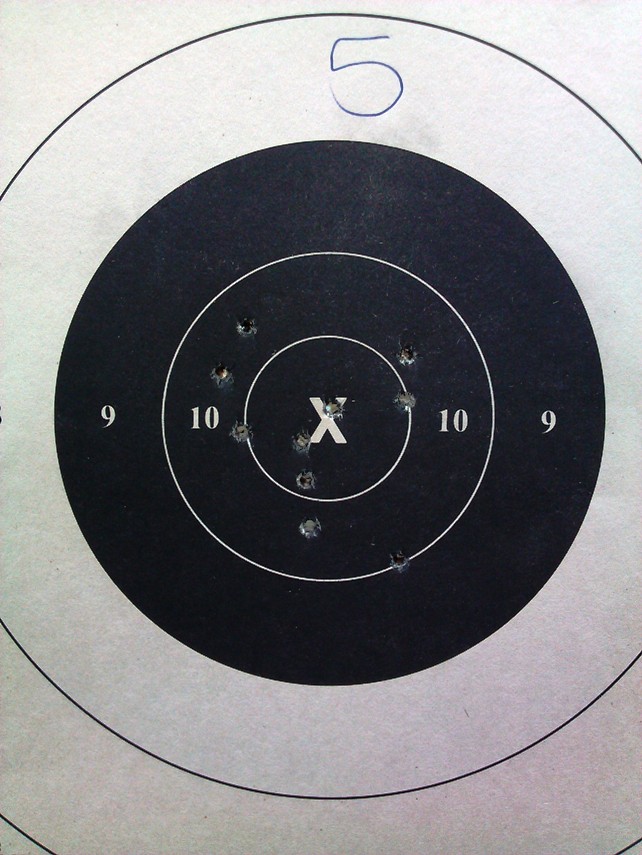
Phenomenal for most of us mortals. Nowhere near good enough to be a national Precision Pistol champ. (photo courtesy Frank Greco)
The Best in the Nation
The NJ State Outdoor Pistol Championship, according to Frank Greco, is the 3rd largest of such events in the nation; the national event, known as the “World Series of the Shooting Sports”, takes place in Camp Perry, Ohio, 40 miles east of Toledo. Events have been held there since 1907.
The overall National Pistol champion for 2015 is Keith Sanderson from Colorado Springs. He scored an incredible 2,655 points out of a possible 2,700. Second was Brian Zins with a score of 2,641. Sanderson is an Olympic gold medalist; Zins was the 2007 NJ State Champion.
To put those scores into perspective, do the math: 2,655 divided by 270 shots equals an average shot score of 9.83…so Sanderson’s average shot was almost always in that three-inch range for ten points, with maybe one or two in a hundred falling outside of it for a nine-pointer.
The difference between Sanderson’s and Zins’ score was just 14 50-yard shots out of 270 that covered a five inch range instead of three.
One wonders if Zins thought about having a donut the week before the match.
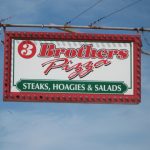
Going Gluten Free in Wildwood NJ
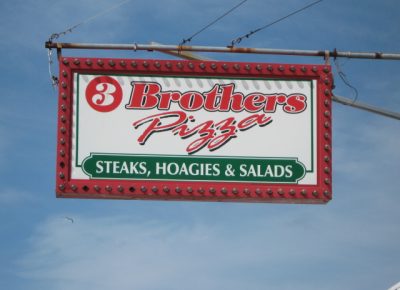
So some years ago…2012 in fact…I wrote a post about going gluten free in Wildwood for my entertaining and informative “Beaches And Boards” blog. I had no idea that post would do so well – as I write this it’s #7 in Google for “gluten free wildwood NJ”.
Anyway, that post is fairly outdated…Westy’s and Juan Pablo’s, sadly, no longer exist…and the situation is much improved for celiacs in the Wildwoods, so I thought I’d share an updated report.
This is by no means a complete list of eateries in Wildwood that offer gluten free menus, but my celiac-afflicted wife and I have tried many of these places, so hopefully it’s helpful to you.
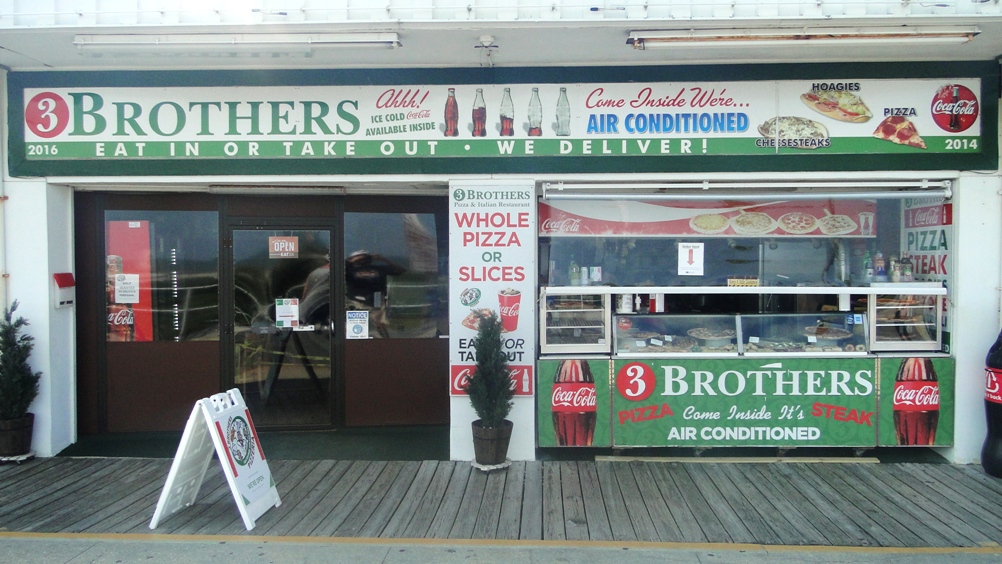
You mean…we can eat here? Really? HOORAY!!
Finally! Gluten Free Pizza on the Wildwood Boardwalk!!
Yes, you read that right! There are now at least three pizza joints on the Wildwood boardwalk with gluten free pizza, and while I am very grateful for this development, it does present a small dilemma.
Here is my minor but significant issue: in my opinion, the gluten free pizza at 3 Brothers is superior to the GF pizza at Sorrento II, but the regular pizza at Sorrento II is superior to 3 Brothers. I haven’t tried any pizza at the Original Hot Spot yet.
Thankfully, the Sorrento II and 3 Brothers aren’t far from each other, so we can often do one or both. Or we take turns. But at least I can finally eat pizza on the Wildwood boards again without feeling bad for my wife. So this is a good problem to have. All of these places deserve a shoutout.

“We spare the expense of a fully lighted sign, and pass the savings on to you!”
Sorrento II. I rank Sorrento II among the best pizza shops on the Wildwood boards for their regular pizza. It was the winner in a pizza-off my brother and I did one night, just edging out Sam’s Pizza Palace…which is also very good, but doesn’t offer gluten free yet. Sorrento II isn’t popular with Yelpers, so I added my two cents there.
Sorrento II is one of those places where you can try some unusual pizza toppings, like BBQ chicken, and it’s a nice thin crust with decent crunch when re-heated (as most boardwalk slices are). You get a decent sized slice for your coin here.
However, while I’m extremely grateful that they offer it, their GF pizza leaves a bit to be desired. It isn’t horrible, but it isn’t great. Given the choice of gluten free pizza in Wildwood only, I’d go with 3 Brothers. But it is nice to be able to go to Sorrento II and have no problem with the wife.
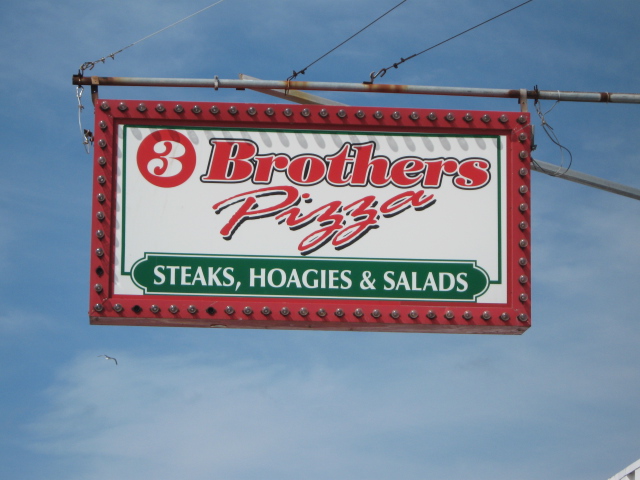
Maybe each brother liked a different font.
3 Brothers Pizza. 3 Brothers, as of this writing, probably makes the best gluten free pizza in Wildwood. Certainly so on the boardwalk, where Sorrento II and Original Hot Spot currently their only competition. I believe they use a crust made from rice, and it’s even edible by traditional pizza standards. My little ones actually prefer it to their regular pizza.
But 3 Brothers’ traditional pizza offering is just okay…and just okay is not okay in a spot where there are dozens of pizza shops that offer very good pies. Don’t get me wrong, it’s adequate and I can enjoy it, but given the choice for non-GF pizza, I’d probably go elsewhere.

Gluten free pizza AND gyros!
Original Hot Spot – The Original Hot Spot offers gluten-free and cauliflower pizza on their menu. We haven’t yet tried it, but I’d avoid this place. My wife and I have eaten there before their GF pizza was available, and while they were able to accommodate her allergy with a roll-free cheesesteak, the food in general was not good.
They are also, according to Yelpers, adding 20% tip charges automatically to the bill. Not wise in times like these. However, again, I haven’t tried the GF pizza yet, so if it’s good, maybe it’s worth that 20% automatic tip for you. They deserve credit for that. Just be mindful.
There’s a reason there are no long lines in front of Original Hot Spots on the Wildwood boards, unlike, say, Sam’s Pizza Palace or Curley’s Fries.
Someone say Curley’s Fries?

If it was the only gluten free food you could get in Wildwood, it would be enough.
Curley’s Fries – GLUTEN FREE!!
My favorite Wildwood food of all is Curley’s Fries – they’re so great that JerseyMan magazine let me do a piece on them and their survival during the Crappiest Year of 2020. Every trip we make to Wildwood includes a stop at Curley’s. But what really makes this iconic fry stand a blessing from God is that they do fries…just fries.
That means that their vats aren’t used for anything trivial like chicken fingers or jalapeno poppers, making them free of contamination and Curley’s fries safe for celiacs to eat. Hooray!
Plus they’re outstanding fries, the best on the Wildwood boards. If there’s one reason for celiacs to vacation in Wildwood, it’s that they’ll be making no sacrifices when it comes to French fried potatoes.

The Vegas Diner doesn’t have specific GF items, but just avoid the bread and you’ll be fine.
Gluten Free Breakfast in Wildwood
You can go to any of several Wildwood diners and eat breakfast safely…we’ve eaten at the Vegas Diner, Adam’s Restaurant, and Pompeo’s without incident…but none of them have specific gluten free menus. They’re all accommodating places, though, so you can generally feel safe.
But there are a few joints that do have a heart for gluten free Wildwood visitors:
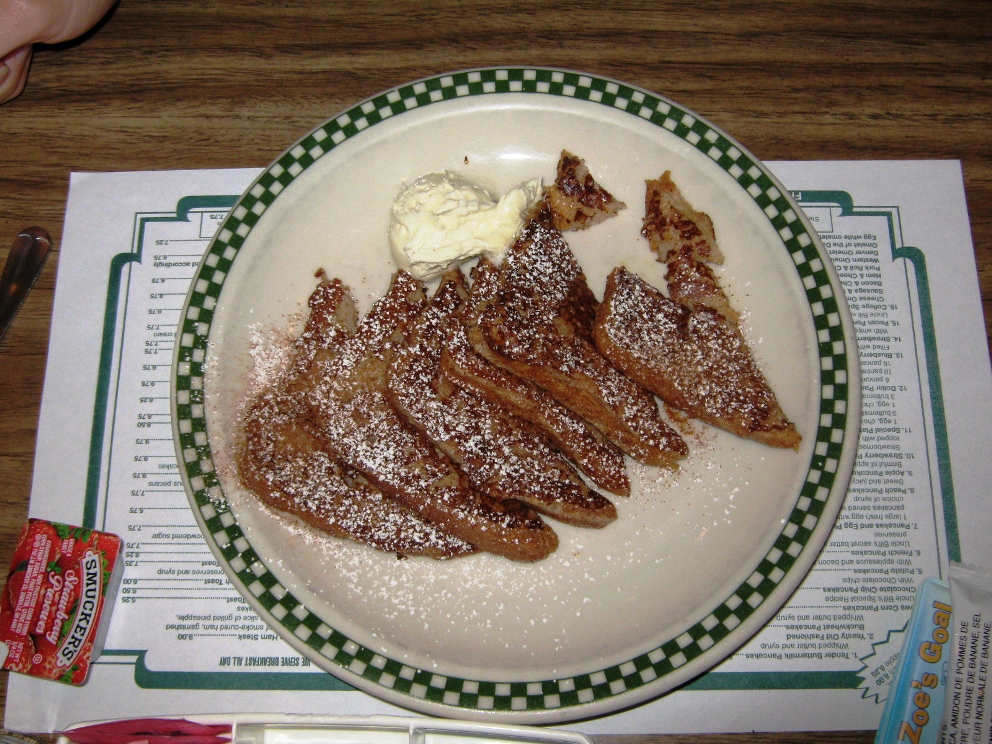
Gluten free French toast? You rock, Uncle Bill.
Uncle Bill’s Pancake House. Learning of Uncle Bill’s offering gluten free French toast was an exciting revelation, because this is another favorite spot of mine. I love their pancakes, and the wife loves the GF French toast. Incidentally, Uncle Bill’s isn’t just in Wildwood…they have locations in a number of Jersey Shore towns.
Incidentally, I don’t see the GF French toast on their menu; I’ve e-mailed and asked about it. I’ll let you know as soon as I get a response.
Bonus tip: Just for your situational awareness. Uncle Bill’s gets very crowded (like I said, it’s a great place), and their parking lot and the one across Pacific Avenue are small and often full…because most people don’t know that there is a larger lot behind the restaurant! Turn onto East Andrews Avenue, go around the block and use that lot.
There you go, a pro tip at no extra charge. (This blog’s full of them!)
Key West Café. The Key West Café is located across East Andrews Avenue from Uncle Bill’s; it’s easy to find. Just look for the colorful bird on the side of the building. Again, you may have some trouble finding a parking spot; don’t use the Uncle Bill’s lot for the Cafe.
I confess that I haven’t tried the Key West Café yet, but they do offer gluten free pancakes, which, like the Café itself, gets positive reviews on TripAdvisor. I’m confident this is a good place to go for celiacs. Hopefully I’ll try it out next time I’m in town.
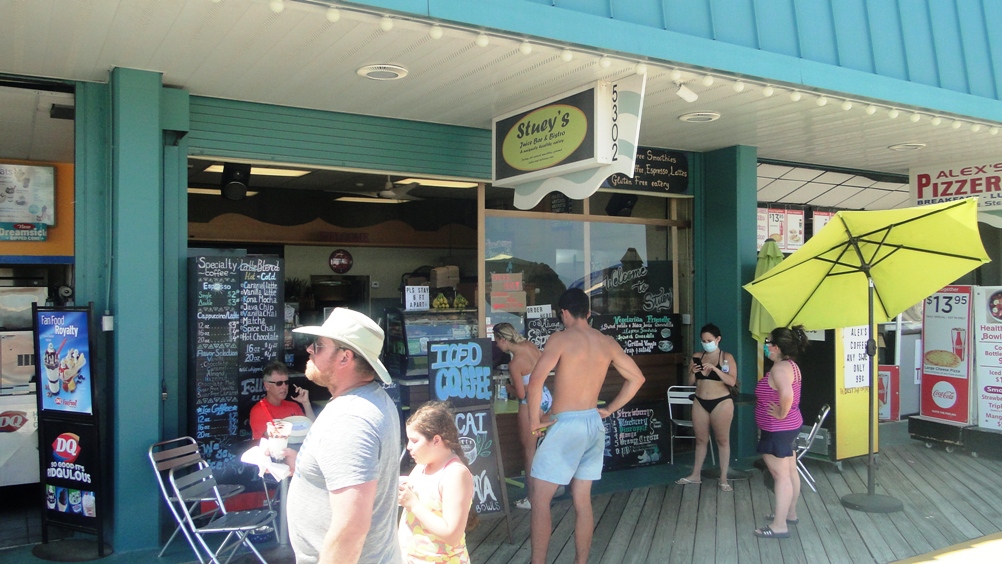
I love places with chalkboard menus.
Stuey’s Juice Bar. We haven’t tried Stuey’s yet either, mostly because we usually stay in North Wildwood, which is a couple of miles away. But Stuey’s is a breakfast spot on the Wildwood boardwalk, at the southern end just north of Wildwood Crest. If you’re staying in one of the hotels on the beach in the Crest, this would make a nice morning spot.
There’s not much in the way of sit down dining, but Stuey’s does offer a wide variety of celiac-friendly stuff, including gluten free pancakes, breakfast sandwiches on gluten free bread, and a bunch of items that wouldn’t have gluten in them to begin with.
Stuey’s also offers smoothies and gourmet coffee, so it’s a win-win.
Gluten Free in Wildwood – Some Other Restaurants That Get It
Here’s a couple of other joints we’ve visited in Wildwood that get the gluten free job done:
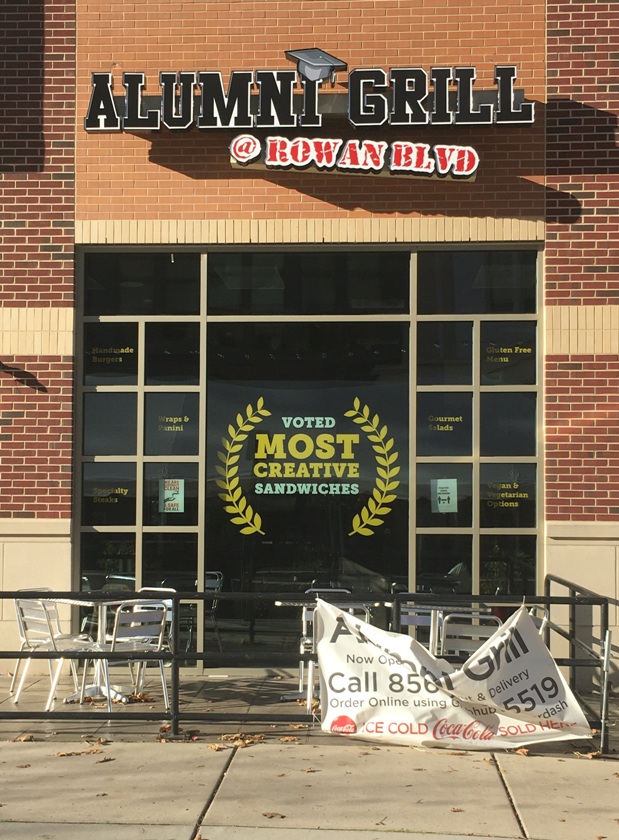
I love the Alumni Grill, and they love me enough to add a location near me!
Alumni Grill. I love the Alumni Grill, and I especially love that there’s now one in Glassboro, just ten minutes away from my house!
The Alumni Grill is perfect for celiacs – the food is great, it’s cheap, and they’re very careful about ensuring that food isn’t contaminated. They actually have a gluten free menu – which includes four types of fries (sweet potato!), and multiple burgers and sandwiches on Udi’s rolls. Their fries are excellent too…they’re not Curley’s, but they’re really good.
The Alumni is great for a cheap takeout (it’s not a great sit down atmosphere), and we use them a lot. It’s a real find in Wildwood for gluten free options.

Great and safe Mexican grub!
(photo courtesy of Bandana’s Mexican Grille)
Bandana’s Mexican Grille. It’s been a long time since we’ve visited Bandana’s, but as I remember it the food was pretty good. And they are definitely aware of allergy issues. They don’t have a specific gluten free menu, but their menu does state which options are gluten free or can be made so. There’s also a page on their website dedicated to allergens, including gluten. That alone makes Bandana’s worth a visit.
They’re reasonable too as Wildwood restaurants go, and Mexican joints are in fairly short supply here. So it’s a solid pick.

Water ice is usually a safe bet. And it’s very good here and at Rita’s.
Gluten Free Desserts!
The Wildwood boardwalk can be a diabetic nightmare, with nearly every other store offering fried or fattening desserts by the truckload.
But going gluten free? No problem! With most any joint that offers ice cream in Wildwood, you can generally get something safe, and the water ice and fudge shops are usually safe too…at least the flavors that don’t include cookie crumbs or whatever. Just avoid fried Oreos, ice cream sandwiches, and stuff like that obviously.
There is one joint that goes the extra mile for those of us afflicted or married to the afflicted:
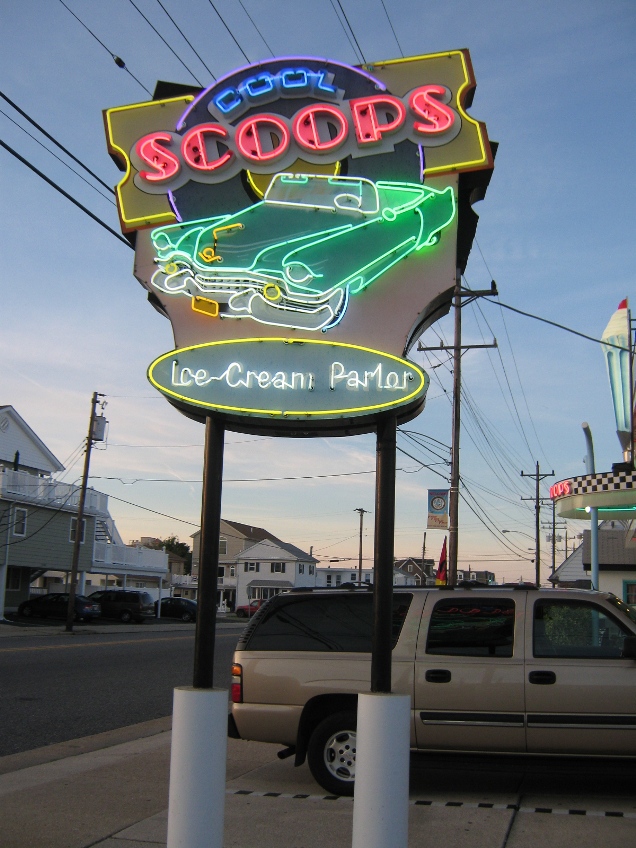
Neon at dusk is always worth a couple extra bucks.
Cool Scoops Ice Cream. Cool Scoops is a classic 1950s style ice cream shop, with a wide variety of very cool variations of sundaes, and that in itself is cool enough. But they also take the simple step of offering gluten free cones. (Not hard to do!!)
It’s not the cheapest ice cream joint (most of them are pricey here), but it’s worth it…you can get an amazing sundae in a fold-up 50s car, and the classic diner atmosphere is fantastic too. A great place to visit with the kids, but especially if you’re a celiac who misses ice cream cones.
We’ve tried Banana’s Ice Cream Café, which supposedly offers GF cones, but we were underwhelmed by it as I recall. Far prefer Cool Scoops, but Bananas deserves a mention.
A Few Other Places We’ve Tried Without Issue
We’ve been to Wildwood many times, and for going out we usually just look for a general place that understands enough to leave out the roll. At times the wife will just bring her own roll, and make a sandwich with that.
I’ve already mentioned some breakfast joints. Here’s a partial list of places where we have been able to eat without incident, so I presume you could go there and be accommodated:

If you’d like a seafood meal in a relatively safe spot, Urie’s works. Great atmosphere too.
Urie’s Waterfront Restaurant. The food here is unspectacular, but the atmosphere is great, right next to the marina. Be sure to ask for a table there for a terrific view. The wife has never had a problem there.
Poppi’s Brick Oven Pizza. Poppi’s doesn’t yet have GF pizza unfortunately, but they have a lot of things they can go gluten free, and their pizza is fantastic for non-celiacs.
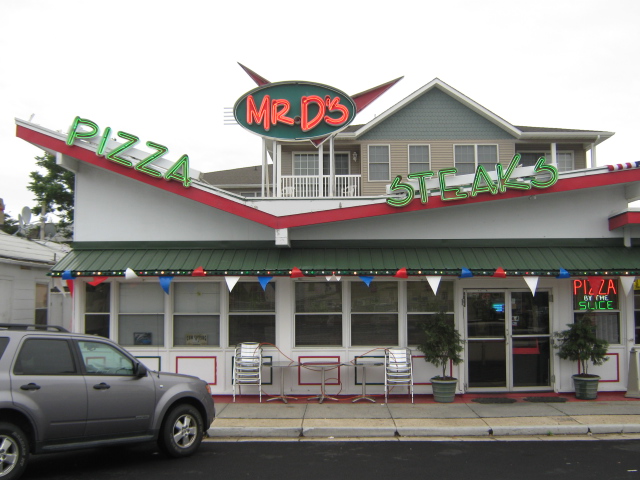
Mr. D’s makes good sandwiches, but you need your own roll.
Mr. D’s Pizzeria And Subs. Mr. D’s moved since we tried them (don’t expect the storefront to look like this photo) – its former location is where Poppi’s is now. But as I recall I believe the wife got a sandwich without the roll and it was fine, and they make pretty good sandwiches for non-celiacs too.
Piro’s. An Italian joint on New York Avenue in North Wildwood. Excellent food, terrific atmosphere, and they have plenty of options for food without bread in it. We like this place a lot.
There you go my friends; hopefully you now have some doable choices for going gluten free in Wildwood. Feel free to drop me a line and let me know if anything has changed.
Did this post make your day a little bit?
I hope so. If it did, I would really appreciate your support.
When you use this link to shop on Amazon, you’ll help subsidize this great website…at no extra charge to you.
Thanks very much…come back soon!

The Great Donut Revolution – Duck Donuts

My article about the amazing Duck Donuts and their history was published in the Summer 2018 issue of JerseyMan Magazine. Click here to see the article on their website, or click here to see the PDF magazine version. Thanks for reading.
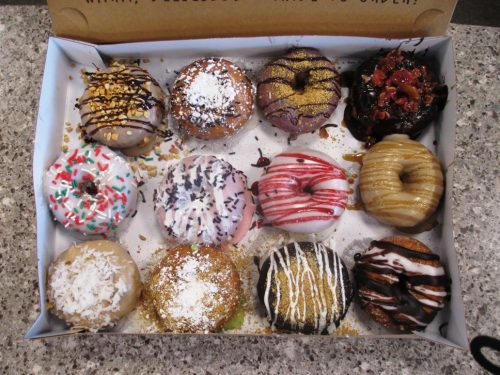
A “duckzillion” combinations of donuts.
Duck Donuts began franchising just five years ago. Today they have sold more than 200 stores, including new openings in Marlton and Avalon. The donut-buying public is ecstatic.
We should all love our jobs as much as Ted Gill does.
It’s refreshing to hear a business professional, with franchise ownership aspirations, unashamedly spout three “really”s describing his product.
“People really, really, really love the idea of fresh, made-to-order donuts,” he says, when asked how business has been since the opening. “Business has been great.”
There’s no measured, calculated tone with Gill. His enthusiasm leads to unabashed exaggeration. “There is a little bit of a wait, but it’s definitely worth it. You get a warm donut, and it’s a million times different than if you got one just sitting around the shelf somewhere.”
Ted Gill is the general manager at one of the newest Duck Donuts locations. He runs the show in the recently opened Marlton store in the Marlton Crossing strip mall, as the rapidly expanding chain of made to order donut shops makes a splash in the Garden State.
A former owner of an East Brunswick pizzeria, Gill found the opening for the Duck Donuts position on Facebook. He spoke with the franchise owners, who probably had an easy time deciding to give him the job. In an age where one bad customer experience gets halfway around the world before a good one gets its pants on, Ted Gill gets it. “People want a fresh, delicious product, and customer service is key. We want everybody to leave here with a smile.”
He plugs his employer like a winning racecar driver. “That’s what we strive to do at Duck Donuts.”
Duck Donuts President Gary McAneney, who is overseeing the company’s ludicrous-speed expansion, shares Gill’s enthusiasm for customer happiness as part of the big picture.
“It is a detail-oriented business. You have to pay attention each and every day to the small stuff,” McAneney says. “I think that’s with any food business, but ours is a little different…we’re discretionary spend. People have choices on whether they’re gonna buy donuts or not. It’s not a must have, so we need to be on top of our game with each and every experience.
“Our franchisees have to understand that. They cannot take their success for granted. Even if the first month or so, lines are out the door and sales are going great, they can’t take their foot off the gas pedal delivering that customer experience.”
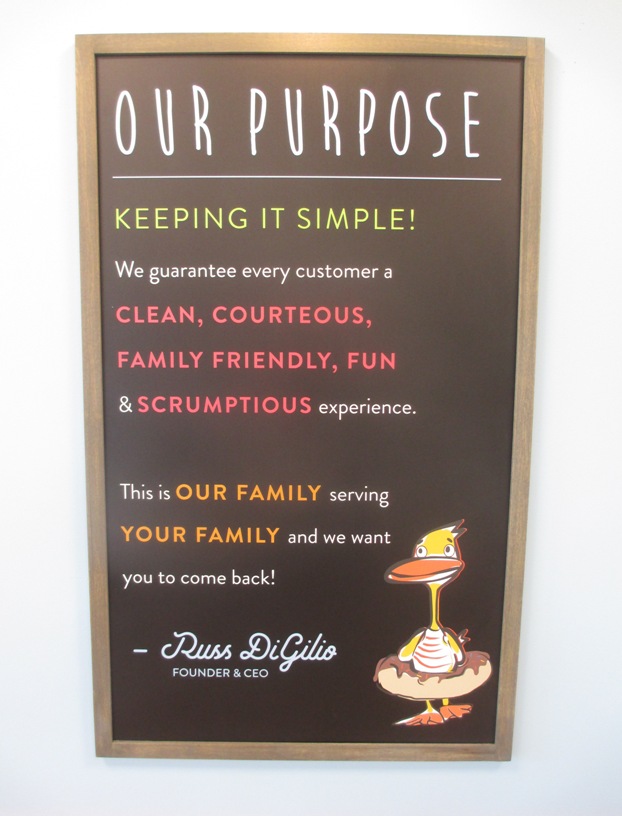
Because we all need a purpose.
During the interview with Gill, customers filter in and are greeted warmly by the staff. Employees behind the counter assist them in the challenging decision of how to coat their donuts, send the brand new donuts through the fryer, and carefully cover them with the requested toppings and drizzles, creating dazzling donut artwork that looks as great as it tastes. All in full view for customers…many of them excited children…to watch.
It’s fair to believe that the experience is rehearsed enough that it isn’t just a show for a writer of a popular magazine. It’s also fair to say the experience is different from well-known large donut chains, who have rested on “acceptable” customer service laurels for decades.
So yes, the quality of service at Duck Donuts is noteworthy. But let’s not discount the quality of the donuts as part of the business plan.
Sitting on the counter is a cake container filled with cinnamon sugar donut pieces, which patrons are welcome to try. Usually the taste results in approval for the complete, paid version, with any of a “duckzillion” combinations of coatings, toppings, and drizzles.
Your fresh and warm donut can be coated with strawberry frosting, Oreo crumbs and hot fudge drizzle. Or try peanut butter frosting, with shredded coconut and blackberry drizzle. And so on. Imagine choosing a dozen combinations like this for your team at work. Imagine your suddenly improved stature within the company as you open the box to display them at the meeting. Can’t think of the right combo? Duck Donuts suggests favorites: maple frosting with chopped bacon (bigger than bacon bits) is beloved of course, as is the Key lime frosting donut with graham cracker crumbs, which is only available in the spring.
When this writer’s arm is twisted enough to try one (resulting in a fairly easy “uncle”), he opts for a breakfast sandwich…a maple covered donut sliced in half, with egg and cheese inside and bacon pieces on top. After some thoughtful consideration of the additional bicycle miles required to work it off, I follow up with the aforementioned Key lime edition.
The verdict? Let’s just say that with Duck Donuts in Marlton now, you’re within an acceptable radius anywhere in South Jersey. Go try them. If you can find a better donut, contact me so I can ask Ken to let me do a story on them too.
The fresh coffee is no slouch either, in case one still thinks that’s a reason to frequent the “leading brand” donut stores.
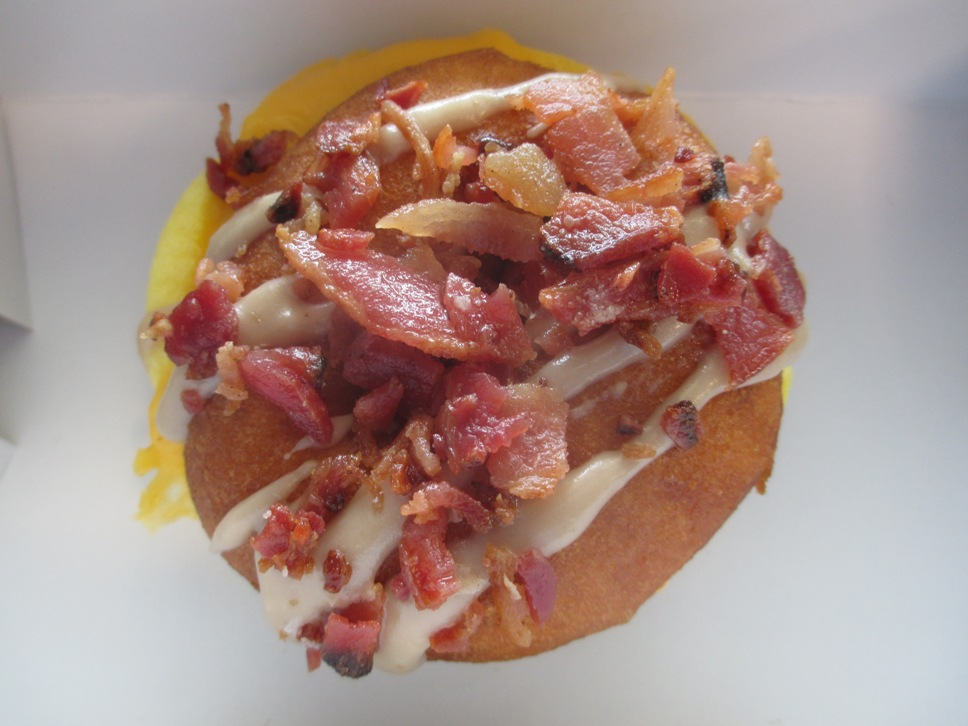
Well worth a wait in a long line.
Duck Donuts founder and CEO Russ DiGilio simply wanted to make the world, or at least the Outer Banks of North Carolina, a better place.
DiGilio, who at the time owned several assisted living facilities, frequently spent vacations with his family in the resort town of Duck (you see where this is going, right?), which, according to Wikipedia, offers “outdoor recreational activities, summer events and concerts, watersports, fine dining, shopping, art galleries, and a nationally known jazz festival.”
The only thing missing from that list, DiGilio noticed, was a fresh donut shop. And so the first Duck Donuts was born.
Well, okay. Don’t quit your day job thinking it’s that simple. DiGilio and his family spent months developing the right combination of batter and shortening…“from absolute scratch”…and researching the market before opening the first store in 2007.
“There are a lot of different food options out there,” DiGilio notes, “and if someone wants to come up with something, they need a niche. They need something unique, a hook to bring people in. You can’t just be any Joe Schmoe hamburger shop. There’s just way too much competition.
“In our days as kids, going to boardwalks and hole in the wall places, we used to get donuts, and they were made to order. You walked up to the window, they made some donuts and you go on your way. Our reminiscing of times when we were on vacation prompted us to do this in a much different way.”
“Fortunately for us, made to order wasn’t very prevalent.”
Nor did it become prevalent in Duck for the first couple of years after the store’s opening. As every business owner knows, success doesn’t come without a struggle. It took some time.
“The first year out of the gate…nobody knew what we were about. On vacation you’ve got a lot of options. It took word of mouth. The third year was the first year we broke even, that’s when it kicked in and we said this has legs. By the fourth year, we knew we had something special.”
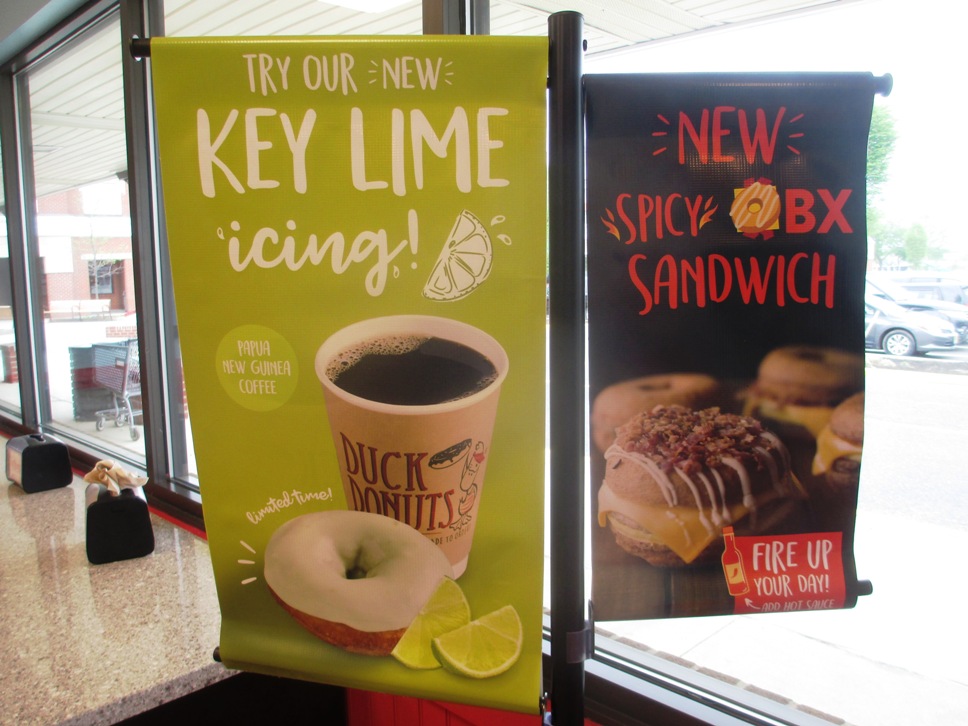
Waiting for spring is even harder than waiting in line, but it’s still worth the wait.
To say word of mouth has been an effective marketing tool for Duck Donuts would be quite the understatement.
It’s one thing to inform your soon to be vacationing friend about the amazeballs donut shop on Osprey Landing. It’s quite another level to repeatedly pester the founder about franchising. Duck Donuts gets so many such offers that there is a prominent page on their website about how to do just that.
“It was surprising to me how much a donut impacted people,” DiGilio recalls, “but when you think about it, the whole idea is family based. People were on vacation enjoying themselves, and it just elicited these memories of while people were on vacation of an enjoyable time.
“It was almost like we had a cult following. We had people write in all the time, telling us how much they love our concept, the donuts were out of this world, and they just loved it. They prompted us, year after year, to come to their hometown or teach them how to do what we do.
“Over time it became so overwhelming that we said, we’re gonna kick ourselves if we don’t test the waters and try to franchise this concept.”
Today Duck Donuts is operational in 13 states, with contracts to open in ten more. The actual number of stores is growing so rapidly that an exact number listed here would likely be inaccurate at press time. There have been 200 locations sold since 2013, with 30 stores likely to open this year alone.
Some pretty impressive numbers in just five years of franchising. But to DiGilio, that first franchise opening, in Williamsburg, VA, is still arguably the proudest moment.
“That couple dipped their toes in the water before anyone else and took a huge risk, which we’re eternally grateful for. But the fact that that store opened with such fanfare and has done so well and continues to this day, in the big picture, set us on our way.”
And if Dunkin Donuts and Krispy Kreme aren’t looking over their shoulders yet, they ought to be.
Did this post make your day a little bit?
I hope so. If it did, I would really appreciate your support.
When you use this link to shop on Amazon, you’ll help subsidize this great website…at no extra charge to you.
Thanks very much…come back soon!
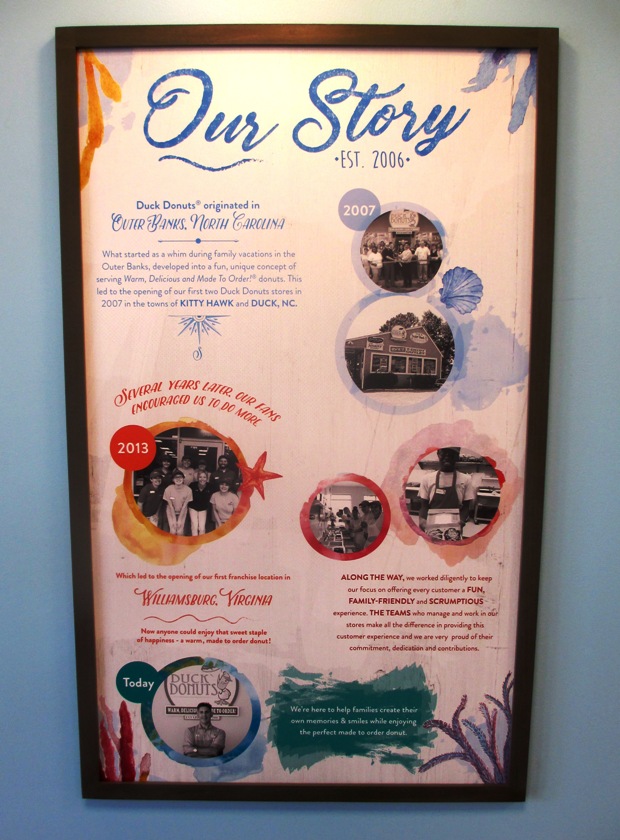
Helping families in more locations all the time.
Quack Gives Back
Duck Donuts didn’t invent the Chemo Duck, as is easy to believe when one initially views the Quack Gives Back page of their website. Which is why the two entities are a perfect fit for each other.
Chemo Duck is a program dedicated to helping children with cancer overcome their fear and anxiety through the inevitably trying therapy. Children are given a “Chemo Duck”, a stuffed yellow duck with hospital scrubs and a chemotherapy port. Parents can use the Chemo Duck to help their children see what their therapy entails and to help ease the child through treatments.
“Obviously what caught our attention was the duck,” DiGilio explains. “Their whole program is based on childhood cancer awareness and education. They’re not really working for a cure, but they are helping the families who are dealing with this type of illness, who need a lot of support and comfort and education.”
This last September (September is Childhood Cancer Awareness Month), all of the Duck Donuts stores gathered together and raised $75,000 for Gabe’s Chemo Duck Program.
“We deal with families, they’re one of our primary customers, mothers with children. This was a nice tie-in, because it’s children dealing with an illness, and they have a duck as their mascot, so it just seemed like a natural relationship. And all families can benefit from what we have to offer and this is our way to give back to those struggling with illness.”
Duck Donuts strongly encourages franchisees to give back, which they are happy to do, through their Quack Gives Back program. The King of Prussia store alone raised over $4,000 for the Children’s Hospital of Philadelphia. “We challenge our franchisees to be connected with their local community,” DiGilio says. “We want our stores to be connected with whomever, nonprofits, baseball teams, high schools, churches, etc..”
If you’d like to learn more about Gabe’s Chemo Duck Program, you can find the website at chemoduck.org.

Ted Gill and crew, ready to share their favorite donut flavors.
The Staff’s Favorites
With all of the duckzillion combinations available to choose from, it’s difficult to choose a favorite. But the management team at Duck Donuts is willing to offer their opinions. It’s a testament to the Duck Donuts recipe how even the people running the show sometimes just love the naked cinnamon sugar Duck donut.
Russ DiGilio, Founder and CEO: Personally, when I’m on vacation, I get pretty basic. I like a cup of our coffee, a cinnamon sugar donut and a crossword puzzle. That’s what I do when I wake up in the morning. When I want some fun I’ll do vanilla icing with coconut shredding and raspberry drizzle. Or lemon icing with coconut shredding and raspberry drizzle, they’re my favorites.
Gary McAneney, President: I’m a little more traditional, I just like the lemon with the raspberry drizzle. When I am, on vacation I’ll do the chocolate just with the rainbow sprinkles are traditional. I think that’s one of our best, to be honest.
Kristin Kellum, PR Manager: It’s really simple, but it’s the cinnamon sugar with vanilla drizzle. That warm donut with the cinnamon sugar is just the perfect combination in my opinion.
Nora Branconi, Co-Owner of the Marlton Store: S’mores, which is chocolate icing, graham cracker crumbles and marshmallow drizzle.
Ted Gill, Marlton Store Manager: My favorite is the cinnamon sugar…it’s simple, there’s a million choices you could choose from, but when the warm donut comes out, and the cinnamon sugar sticks to it, it is absolutely delicious. Now, I like all the donuts. The bacon maple donut is delicious. What’s not to like about bacon?
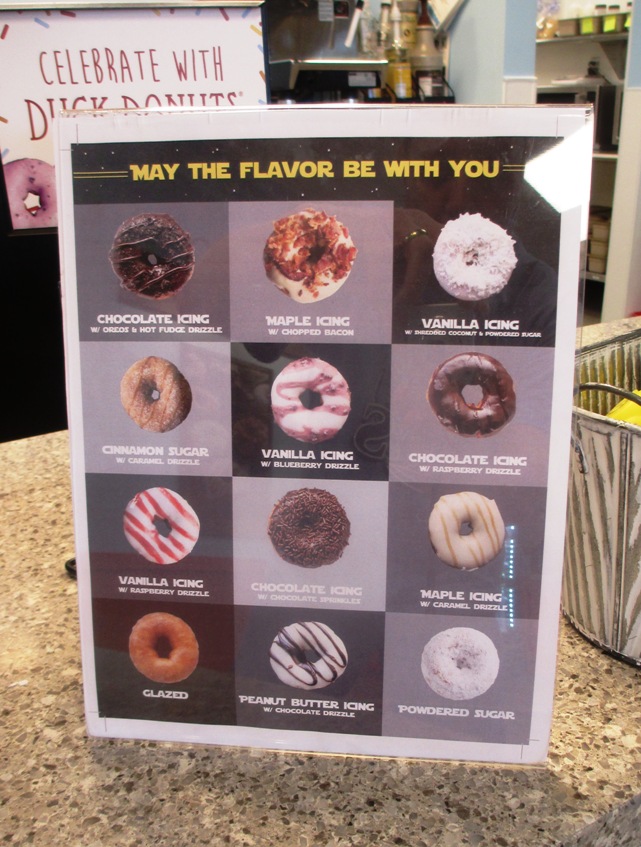
The Jedi Mind Trick: “You can say you love Duck Donuts on Yelp.”
The Critics Rave!
Just a few months into the opening of the Marlton store, Yelp has 37 reviews as of this writing, averaging four stars. Here’s what a few of the customers are saying:
“They don’t make the cheapest donut or the fastest donut, so if you want that, Duck Donuts isn’t for you. But if you want the best donut you ever had, no doubt partially because you got to pick the topping and drizzle on it, Ducks is for you.” – Matt W., Williamstown, NJ
“Trust me when I say you are in for a treat when you come to Duck Donuts. The staff is friendly and the donuts are amazing! This is my favorite donut place in South Jersey!” Nicci G., Burlington, NJ
“I’m so glad you’re a part of the neighborhood. Really. Your donuts are made fresh, on the spot, and your staff is so nice…GREAT DONUTS. GREAT PEOPLE. Thank you!” – Ashley T., Philadelphia, PA
“I had the pleasure of first trying Duck Donuts but from their KOP location. Last year when I found out they were moving into a Marlton location I couldn’t control my excitement. I have been counting down the days to the grand opening and here it is.” – Abigail W., Evesham Township, NJ
“This is a hot new location that will be buzzing for months! Yelp will assist in blowing this up even more and bringing attention to these amazing holes of deliciousness!” – Jason D., Marlton, Evesham Township, NJ
“If you gave this place any less than 5 stars, I don’t think you actually went here. It was busy at 5pm, on a Thursday, in the rain! C’mon people, this place is off the hook. Come one, come all, put all the Dunkin Donuts in the area out of business!!!” – Christopher C., Marlton, NJ

Homesickness factor: zero.
Going Global
If you were apprehensive about a South American vacation because of the absence of Duck Donuts, that’s no longer a problem for you. As this article goes to press, Duck Donuts has recently announced an expansion into the Southern Hemisphere, with ten stores opening in Chile.
According to the official press release, Duck Donuts has signed an international franchise agreement with OBX Alimentos SpA. Their CEO, Marcial Dieguez-Acuna, is quoted as saying “We look forward to having Chileans adopt this new concept with open arms and for Duck Donuts to become a significant player in the sweets industry in Chile. We will offer a superior product to current market standards and with the highest level of quality service.”
Given that the business model is working pretty well in America, it’s not hard to imagine that Chileans will take to Duck Donuts just as quickly. Russ DiGilio says the company is pursuing more international franchising opportunities.
In a few years, you may be able to get a Duck Donut wherever your vacation plans take you.

Northlandz Miniature Wonderland Railroad Museum

Sometimes JerseyMan lets me come up with my own assignments, so I got to visit Northlandz in Flemington, NJ … the Model Train Capital of the World! This article appeared in the Spring 2020 issue of JerseyMan; click here to see the PDF.

Kind of like the railroad version of the I-295/I-76/I-676/NJ-42 interchange.
All Aboard!
The Northlandz Railroad Museum in Flemington was listed in the Guinness Book of World Records as the world’s largest model railroad. Bruce Williams Zaccagnino’s creation is now the beneficiary of new ownership, an expensive makeover, and finally, the marketing respect it richly deserves.
Julie Parker’s occupation was to tell people about businesses worth visiting in Flemington.
And she had never heard of Northlandz.
That’s roughly the equivalent of being in charge of Philadelphia tourism, and not being aware of Independence Hall, the Liberty Bell, the Art Museum, and the Reading Terminal Market.
It wasn’t Parker’s fault, though. The genius behind Northlandz is an excessively modest man, who cared more about creating his art than promoting it.
She fondly remembers meeting him.
“I was doing the Flemington Information Center. Somebody told me, you’ve got to go see Bruce Williams, he just opened this place called Northlandz. I said, okay, maybe I can promote him. I had a group of businesses that would pay me and I would promote them all over Flemington.
“He actually had me go through it, and I came out and I looked at him and I said, ‘Oh my God, you built this whole place yourself?’”
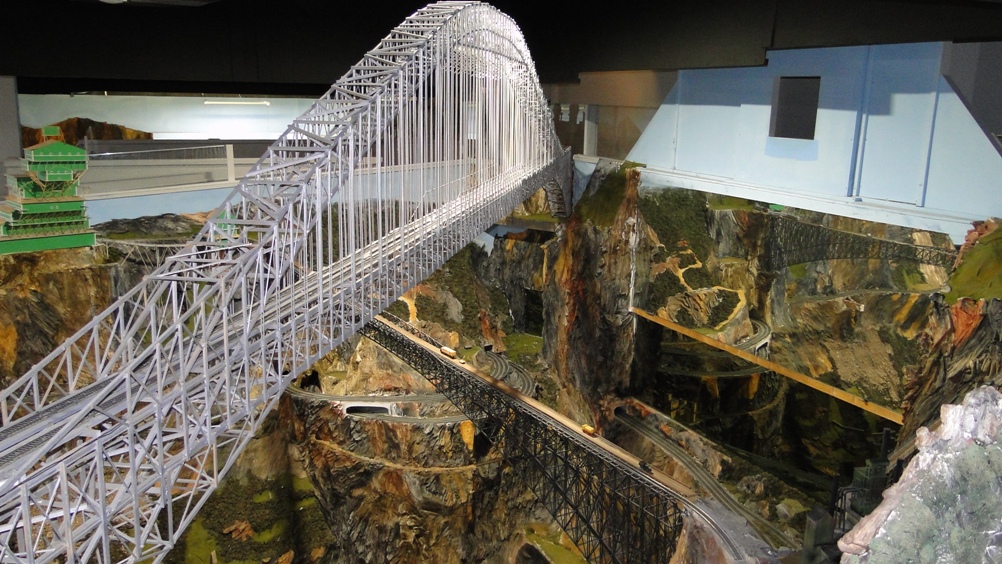
This is about 1/100th of Northlandz.
If that story is remarkable, it gets better. This phenomenal exhibit of a hobby taken to an unimaginable extreme was almost decimated.
Thankfully, the building fell into the right hands…businessmen with more enthusiasm for putting smiles on faces than for profit.
Tariq Sohail, one of the new owners, was equally shocked and amazed in his first visit to Northlandz. He was minding his own business looking for a storage warehouse, and came upon a large gray building off Route 202 that might work.
“We drove past it so many times. I never knew what it was. Our real estate guy said, if you don’t like what’s inside, you can always demolish it.”
As Sohail describes his reaction to seeing what was inside, Parker chuckles, as if fully appreciating the astonishment factor.
“We started going through the whole tour,” Sohail continues. “We were like, in our lifetime, nobody has ever built something like this. We’ve traveled throughout the world, we’ve never seen anything like this.
“So we decided to take a risk and invest into it and promote it.”
That they’ve done. Northlandz needed work, to be sure…read reviews from a few years ago and you’ll see a lot about the state of disrepair it was in. Sohail and his partners have thus far poured several hundred thousand dollars into cleaning it up, and the results are nothing short of remarkable.
“There are people that came three or four years ago and they say, we can’t believe the difference,” Parker says proudly.
The new ownership has a larger vision for Northlandz too…it includes shuttle buses from New York City, a hotel, a banquet hall, and much more. All revolving around a toy train set.
That said, it is one truly amazeballs train set.

People like to live dangerously here.
Northlandz is, simply put for brevity, the world’s largest model railroad, according to the Guinness folks who are experts on such things. It spans over 45,000 square feet and 16 acres. The walkway just to go through it is over a mile.
To give you an idea of just how staggering its size, this observer had taken over a hundred pictures before reaching a sign that reads: “You are now 25% through Northlandz”.
Every moment is sheer model railroad wonderment. Huge displays filled with mountains and bridges, offering backdrops to bucolic still life of homes, factories, rivers, and neighborhoods. There’s “Iron Valley”, with its multiple iron bridges gracefully leading through mountain tunnels. There’s “Joycetown”, with churches, homes, and model trucks decorated with staples of American commerce like Kodak, Dollar Tree and Valvoline. There’s a fully detailed city mockup featuring an aircraft carrier. And a display of mountain life with busy railroads throughout that literally occupies three floors of the building. Tunnels? Northlandz features over four hundred of them.
On and on and on.

Like a scene from The Fugitive, isn’t it?
Any one of these displays could be the highlight of nearly any museum in the country. You could literally spend hours in one spot, watching a toy locomotive charmingly meander through a perfectly scaled-down neighborhood.
And this marvel was nearly all built by just one person.
Sohail estimates that Zaccagnino spent 17-19 hours daily, seven days a week, for close to four years building a miniature world. As one can imagine, he received little to no support from family members…as if spending eight hours a day and five days a week in a cubicle somehow makes more sense. According to Sohail, only Bruce’s wife Jean always supported the venture.
You could probably be forgiven for thinking your neighbor was crazy for devoting even sleeping hours to building a model railroad.
Then you see the finished work, and you realize crazy people are awesome.
“You won’t believe your eyes” is Northlandz’s slogan, and despite seeing it every day…Parker is currently the Northlandz Marketing and PR Director…she repeats those words herself often, with genuine passion that every employee shares.
“I just feel it’s magical,” she gushes. “How can somebody have conceived this? It’s incredible. You go through it and you start seeing all these little trains going in the little villages and the different themes and the different venues.”
“Everything is built by hand,” Sohail adds. “He told us one of the bridges that he built is 40 foot long, 23,000 small wood pieces, that he put together one by one by one by hand.”

Yes, I would go to church before crossing that bridge too…
Ask anyone working at Northlandz what the appeal of a huge model train set is and you’ll get a different answer.
Parker thinks it’s the glimpse of history.
“I think it goes back to the industrial revolution. Trains made our country great. They transported everything. Food, industry, it’s like the backbone of our economy. Buses, trains and cars, they’re what makes the economy tick.”
Sohail believes the appeal reaches us on multiple levels. He refers to young people who come to work at Northlandz and help with the layouts out of pure passion.
“Within the train layout, you have to have more than one skill. It’s architecture, it’s engineering, it’s electrical, it’s design, it’s scenery. Basically doing one hobby, you’re learning all different skills.”
Ken Vogel, a train technician, generously took time to point out multiple intricacies of Northlandz during this interview. He remembers his own days of building model trains, and bringing one of his fellow hobbyists to Northlandz for the first time.
“Bruce signed a box car that we brought here from my nephew. What I said to him at that time was, I know a lot of people that are remodelers who always wanted to build an empire and never did it. I said, you’re the only one that did.”

Who knew miniature life could be so much fun?
Sohail thinks the moving train gives life to a piece of art. “You’re looking at something beautiful going up and down, and all of a sudden the train comes.”
Worth putting over $300,000 into preserving? No question for Sohail. “Every time I come, it excites me as well, even when I own it. I see the people coming out of the place and I see how big the smiles on their faces and how happy they are to see it.
“That’s made me happy.”
Walking through the magical railroad empire that is Northlandz, one gets a sense of needing to be of advanced age to fully appreciate the endeavor. The longer you’ve spent on Planet Earth, the longer you’ve gone without witnessing anything like it.
But even this observer’s little ones can’t wait to go back.
Did this post make your day a little bit?
I hope so. If it did, I would really appreciate your support.
When you use this link to shop on Amazon, you’ll help subsidize this great website…at no extra charge to you.
Thanks very much…come back soon!

Isn’t “largest miniature railroad” like “light heavyweight”?
If You Go (And You Should)
If you are at least enough of a model train enthusiast to, say, put a little track under your Christmas tree each year, you have to visit Northlandz. In most any search for “largest model railroad in the world” or “largest model train display”, you will find Northlandz in the list.
The most important piece of advice for going is this: devote an entire day to your visit, whether you’re bringing the grandkids or not. You may be able to enjoy all of the exhibits in an hour, or you may want to take more time to fully appreciate the astonishing level of detail…and that can truly take a full afternoon.
There is a kids play area in the middle of the museum, which features an organ that Zaccagnino would play for visitors from time to time. Zaccagnino is retired now, but there is still enough to give the little ones a break before they see the rest of the museum.
You can find a few complaints online that Northlandz is on the pricey side, although it’s well worth every penny in this observer’s opinion. That said, there are online coupons to take a few bucks off of the price…just search for “Northlandz coupon”. Military, teachers and seniors get discounts, and persons with disabilities get in for free.
It’s easy to get to Northlandz in less than an hour or so from the Philly area, but should you need to spend the night, there is a Travel Inn & Suites just steps away down the road, and a Hampton Inn a bit further away in the heart of the shopping area of Flemington. The Hampton tends to get better reviews.
If you’re hungry there’s McDonald’s, Chick-Fil-A, and multiple other restaurants where U.S. 202 meets NJ-31 just a short drive away.
One last thing…if you take the kids, they’re going to want to go back. Not that you’ll mind.
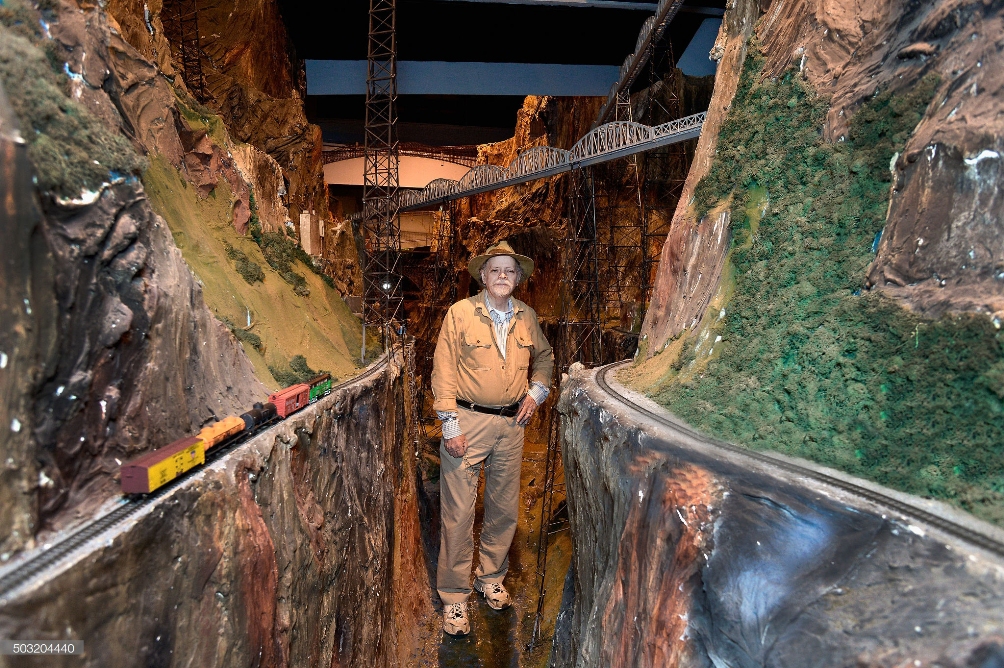
The genius behind it all. (Photo by Paul Marotta/Getty Images)
The Man Who Built It
Bruce Williams Zaccagnino got started in the same place most all model railroad enthusiasts do: in his basement. More correctly, in a basement of a house that was being constructed, according to the Northlandz website. The construction workers would leave for the day, and he would build mountains and tracks in his new basement.
Like today, nearly everyone who saw his work was quite impressed, to the point where he would open it for the public on weekends. He purchased the land on Route 202 as the popularity grew, and the rest is history.
Zaccagnino was no stranger to artistry, incidentally. He made a decent amount of money in the video game industry, including winning several awards as a developer/designer. He was, according to Sohail, quite the accomplished musician as well. “I watched him play the organs that we have over here. I never saw anybody play that well.”
But Northlandz was his passion, obviously. To the point where he spent his time building his dream, rather than marketing it. Sohail compliments his modesty, but expresses regret that his people didn’t meet him sooner.
“We would have promoted this throughout the world,” he says.
“He’s been interviewed with CNN and Fox, all the major, you know, and he never made a big deal out of that. He’s in the Guinness world records, this place, and he never even promoted that fact. We saw the certificate, it’s sitting on the exhibit and anybody could take it.”
“Bruce didn’t really advertise; he let itself advertise,” says Ken Vogel. “The point was, it was a guy who had a dream about building a great layout and actually pulled it off. The dream is accomplished.”
Zaccagnino is retired now…traveling, according to Julie Parker, so one guesses he’s actually riding trains instead of building them. But he’s appreciative that his art is going to live on.
“I think he was starting to see that a lot of stuff was falling apart,” Sohail reflects. “He had a feeling like if somebody doesn’t save it, it’s going to go away. When we bought it and we started repairing it and cleaning up and everything, he was very happy, you know, my art is being preserved.
“He said, this is my gift to the world.”

The Old Ball Game – SJ Men’s Senior Baseball League
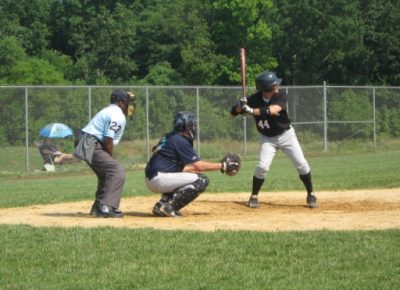
The South Jersey Men’s Senior Baseball League is a haven for men in their advanced years who still can and want to play some baseball. I wrote this piece for the August 2012 issue of JerseyMan; you can view the PDF from the magazine here.
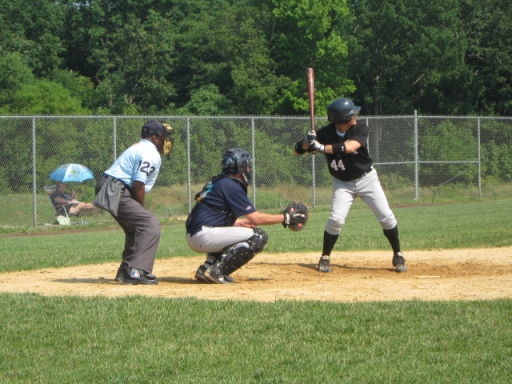
Waiting on the high hard one, adjusting for everything else.
The Old Ball Game
After 20 years, the South Jersey Men’s Senior Baseball League is stronger than ever.
On a picture-perfect Sunday morning at Doc Cramer Field in Manahawkin, the Hammonton Black Sox are playing hooky from church to play baseball, in a time-honored tradition that a Benevolent Supreme Being isn’t likely to mind.
With his team shorthanded, manager Mike Dunleavy must take the field and has enough to keep him busy, so he lets this observer keep score in their game against the Ocean Pirates. At one point a Sox player slaps a weak chop that travels about ten feet but successfully moves the runner on first over to second. There is a dispute over whether it counts as a sacrifice. “You’d be surprised at how much these guys look at their stats,” Dunleavy tells a writer who, as a former softball player, is sure he wouldn’t be surprised at all.
The team has several batters hitting over .400, but they’ve managed little offense in this game. “Junkballers,” the manager says, of his hitters’ performance against the Pirates’ Jeff Martin. “We always have trouble with them.”
In the bottom of the ninth, he calls a conference on the mound with his pitcher Tom King, to figure out how to pitch the Pirates’ Eddie Titley with a runner on second and the game tied. Over King’s objections, Dunleavy orders Titley to be put on intentionally. King, who has pitched a fine game, walks the next two batters, and the Pirates take a 3-2 victory over the Black Sox with two runs in the ninth. Despite its painful obviousness, the manager feels compelled to point it out: “Tough loss.”
Following the game there is a brief shouting match in the dugout between Dunleavy and King over the decision to walk Titley, which is fairly quickly smoothed over. It’s not a contract year, after all.
“From eight to eighty, the game is the same,” Dunleavy says. “It’s still about pitching and defense. There’s nothing I can tell these guys that they don’t already know.”
And so it goes in the senior fast pitch baseball world.
Dunleavy has managed Hammonton’s team in the 45+ American Division for seven years. When his team is shorthanded he will take the field, and occasionally he takes the mound to pitch. At his advanced age, he isn’t stealing bases or hitting bombs or overpowering hitters, but like most pitchers he can still pitch a successful game if he keeps the ball down. The Pirates, he says, are their friendly arch rivals—the Black Sox had lost to them two years before in the championship game, and had beaten them last year for the championship. It’s not Yankees-Red Sox, but it still fires up both teams.
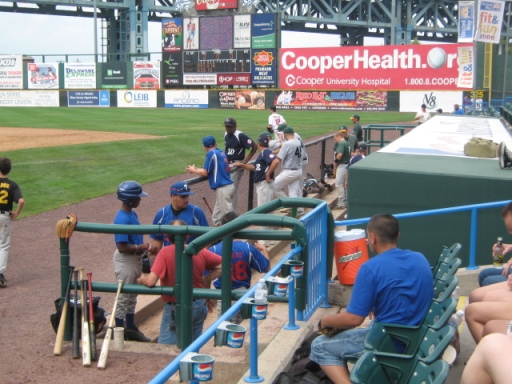
Taking the field in Camden for the All-Star contest.
On July 15 of this year, the South Jersey Men’s Senior Baseball League celebrated its 20th anniversary at Campbell’s Field in Camden. In a brief on-field ceremony, league president Lou Marshall and vice president Neil Hourahan presented league founder Bill Curzie with a plaque, as a thank you for being the indefatigable spark for the SJMSBL and a key ingredient of the glue that has held the league together for 20 years. Whether it is attributable to the league’s success is not certain, but Curzie does not appear to have aged at all in two decades, and at 77 still looks fit enough to play two.
In 1992, at the age of 57, Curzie met up with players of a Pennsylvania division of the MSBL, and asked about setting up a fast pitch baseball league in South Jersey, which had none at the time. National league president Steve Sigler enthusiastically gave Curzie permission, and off he went.
With the help of a story in the Burlington County Times—that began with the words “Curzie is serious”—Curzie spread the word quickly. It turned out that South Jersey was heavily populated with thirty-, forty-, fifty- and even sixty-somethings who still wanted to play ball—and didn’t mind faster pitches or nine innings, the way the game was meant to be played. In less time than it takes a superstar free agent to say “it’s not about the money”, there were enough players for four teams, and the league began with six.
With the help of Curzie’s equally dedicated assistant commissioner Gary Brown, the SJMSBL kept growing, and is now the second largest senior fast pitch league in the nation, with over 1,200 players in four age brackets. There’s been a 25% growth in the 18-year-old group, which bodes well for the long term health of the league. They are adding a 55+ division next season.
Curzie shares the story of his standing firm on the league moving to wooden bats, after the national disgrace of aluminum bats had been the norm for some years in nearly every league. Today, most fast pitch leagues are back to using wooden bats, and Curzie humbly accepts some of the credit for that. When asked the ridiculous question of why wooden bats over aluminum, he has a simple response: “It’s just baseball, man!” He does elaborate further, though. With the reflexes of players at this age, aluminum bats are more dangerous, and besides, there are too many cheap hits with aluminum.
Today Marshall and Hourahan now handle the running of the league. The list of administrative tasks is long. In the beginning of the season, Marshall must be in continuous contact with the national headquarters of the MSBL, ensure that fees are collected, manage schedule changes, work with the umpires’ organization, deal with the inevitable problems that teams will have with the schedule, and arrange the All-Star weekend in Camden.
It’s a lot of work maintaining the league and playing on top of it—a full time job, Marshall admits. It’s all worth it, of course. He echoes the sentiment of the players on the field: “you feel like you’re eight again.”
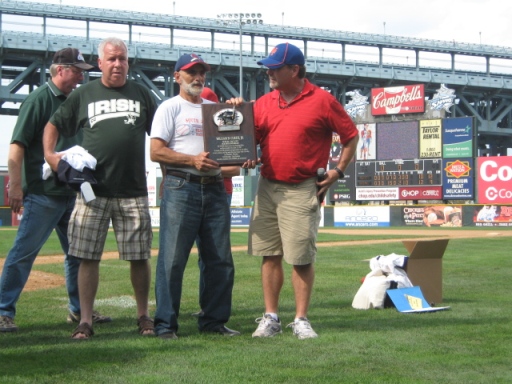
Bill Curzie accepts an award for putting players back on the field again.
There aren’t hot dogs, exploding scoreboards or the roar of the crowds. You won’t see players at the level of Andrew McCutchen or Mark Teixeira here. But you might appreciate, as these fellows do, how difficult it really is to throw out a baserunner attempting to steal or to turn a double play. Dunleavy says, “Hunter Pence can throw out a guy at third base. We would need a couple of extra throws to get the ball there.”
Perhaps, but that’s an exaggeration that doesn’t give credit to the skills many of these fellows have.
They wear uniforms and cleats. They steal bases. They take advantage of fundamental mistakes. They throw the ball around the horn after a strikeout. They use leg braces and pine tar. Balks and infield flies are called. There are rundowns, pickoffs, and lots of spitting. There is pressure to win, real trophies, and real statistics displayed online that people from here to Cambodia can see.
Some players even look for that little bit of rule-bending edge. Marshall tells the story of a pitcher loading a ball with tobacco juice and snot; eventually he even bought a container of K-Y at the store with his wife present—assuring her it was for his “other slider”.
Being an umpire, which pays in the neighborhood of $80 a game, is just as thankless a job as it is at any level of baseball. Players gripe about calls throughout the game, which the ump, who wants to appear professional just as the players do, mostly takes in stride. Between innings an umpire shares stories about rare times where he’s ejected players. One involved a thrown bat making a loud clang; another involved foul language directed at him. But most times, he says, if he’s got to be out in the heat, then so do they.

Stars of the league.
The SJMSBL is a haven for men refusing to age—who desire to compete on the highest level they can, relive the playing days of their youth, and many times to do both.
Anyone can sign up and play. It’s a time commitment; players give up a day of their week, in this case a Sunday morning. They’ll need legs too; they’re going to be running the full 90 feet between the bases. Some of them will get hurt in battle; many of the Black Sox’s best are currently on the DL. During the interview, Marshall—who still plays while running the league—shows me elbow scabs from sliding.
Never once does it occur to any of them that none of the games will be on television, that they won’t be driving a Porsche with their contract, or that it’s highly unlikely anyone besides an insurance company will ask for their signature. They are playing a boy’s game again, and loving every second of it. Who wouldn’t leave it all on the field?
Dunleavy remarks: “I have seen in the faces of the older guys what men’s senior baseball has done for their spirit. They never thought that they would ever get the chance to actually suit up and play competitively again.”
From eight to eighty, the love of the game is the same too.












